Essay on Mahatma Gandhi – Contributions and Legacy of Mahatma Gandhi
500+ words essay on mahatma gandhi.
Essay on Mahatma Gandhi – Mahatma Gandhi was a great patriotic Indian, if not the greatest. He was a man of an unbelievably great personality. He certainly does not need anyone like me praising him. Furthermore, his efforts for Indian independence are unparalleled. Most noteworthy, there would have been a significant delay in independence without him. Consequently, the British because of his pressure left India in 1947. In this essay on Mahatma Gandhi, we will see his contribution and legacy.


Contributions of Mahatma Gandhi
First of all, Mahatma Gandhi was a notable public figure. His role in social and political reform was instrumental. Above all, he rid the society of these social evils. Hence, many oppressed people felt great relief because of his efforts. Gandhi became a famous international figure because of these efforts. Furthermore, he became the topic of discussion in many international media outlets.
Mahatma Gandhi made significant contributions to environmental sustainability. Most noteworthy, he said that each person should consume according to his needs. The main question that he raised was “How much should a person consume?”. Gandhi certainly put forward this question.
Furthermore, this model of sustainability by Gandhi holds huge relevance in current India. This is because currently, India has a very high population . There has been the promotion of renewable energy and small-scale irrigation systems. This was due to Gandhiji’s campaigns against excessive industrial development.
Mahatma Gandhi’s philosophy of non-violence is probably his most important contribution. This philosophy of non-violence is known as Ahimsa. Most noteworthy, Gandhiji’s aim was to seek independence without violence. He decided to quit the Non-cooperation movement after the Chauri-Chaura incident . This was due to the violence at the Chauri Chaura incident. Consequently, many became upset at this decision. However, Gandhi was relentless in his philosophy of Ahimsa.
Secularism is yet another contribution of Gandhi. His belief was that no religion should have a monopoly on the truth. Mahatma Gandhi certainly encouraged friendship between different religions.
Get the huge list of more than 500 Essay Topics and Ideas
Legacy of Mahatma Gandhi
Mahatma Gandhi has influenced many international leaders around the world. His struggle certainly became an inspiration for leaders. Such leaders are Martin Luther King Jr., James Beve, and James Lawson. Furthermore, Gandhi influenced Nelson Mandela for his freedom struggle. Also, Lanza del Vasto came to India to live with Gandhi.

The awards given to Mahatma Gandhi are too many to discuss. Probably only a few nations remain which have not awarded Mahatma Gandhi.
In conclusion, Mahatma Gandhi was one of the greatest political icons ever. Most noteworthy, Indians revere by describing him as the “father of the nation”. His name will certainly remain immortal for all generations.
Essay Topics on Famous Leaders
- Mahatma Gandhi
- APJ Abdul Kalam
- Jawaharlal Nehru
- Swami Vivekananda
- Mother Teresa
- Rabindranath Tagore
- Sardar Vallabhbhai Patel
- Subhash Chandra Bose
- Abraham Lincoln
- Martin Luther King
FAQs on Mahatma Gandhi
Q.1 Why Mahatma Gandhi decided to stop Non-cooperation movement?
A.1 Mahatma Gandhi decided to stop the Non-cooperation movement. This was due to the infamous Chauri-Chaura incident. There was significant violence at this incident. Furthermore, Gandhiji was strictly against any kind of violence.
Q.2 Name any two leaders influenced by Mahatma Gandhi?
A.2 Two leaders influenced by Mahatma Gandhi are Martin Luther King Jr and Nelson Mandela.
Customize your course in 30 seconds
Which class are you in.

- Travelling Essay
- Picnic Essay
- Our Country Essay
- My Parents Essay
- Essay on Favourite Personality
- Essay on Memorable Day of My Life
- Essay on Knowledge is Power
- Essay on Gurpurab
- Essay on My Favourite Season
- Essay on Types of Sports
Leave a Reply Cancel reply
Your email address will not be published. Required fields are marked *
Download the App


Essay on Mahatma Gandhi [100, 150, 200, 300, 500 Words]
Essay on Mahatma Gandhi in English: In this article, you are going to read short and long essays on Mahatma Gandhi in English (100, 150, 200-250, 300, and 500 words). This article will be also helpful for you If you are looking for a speech on Mahatma Gandhi or Paragraph on Mahatma Gandhi in English. We’ve written this article for students of all classes (nursery to class 12). So, let’s get started.
Table of Contents
Short Essay on Mahatma Gandhi 100 Words
Mahatma Gandhi was one of the greatest leaders of our country. He was born in Porbandar, India, on October 2, 1869. His father Karamchand Gandhi was the Dewan and his mother Putlibai was a pious lady. Gandhiji went to England to become a barrister. In 1893 he went to South Africa and worked for the rights of our people.
He returned to India in 1915 and joined the freedom struggle. He started many political movements like Non-cooperation movement, Salt Satyagraha, Quit India Movement to fight against the British. Gandhiji worked for the ending of the caste system and the establishment of Hindu-Muslim unity. He was killed by Nathuram Godse On January 30, 1948.
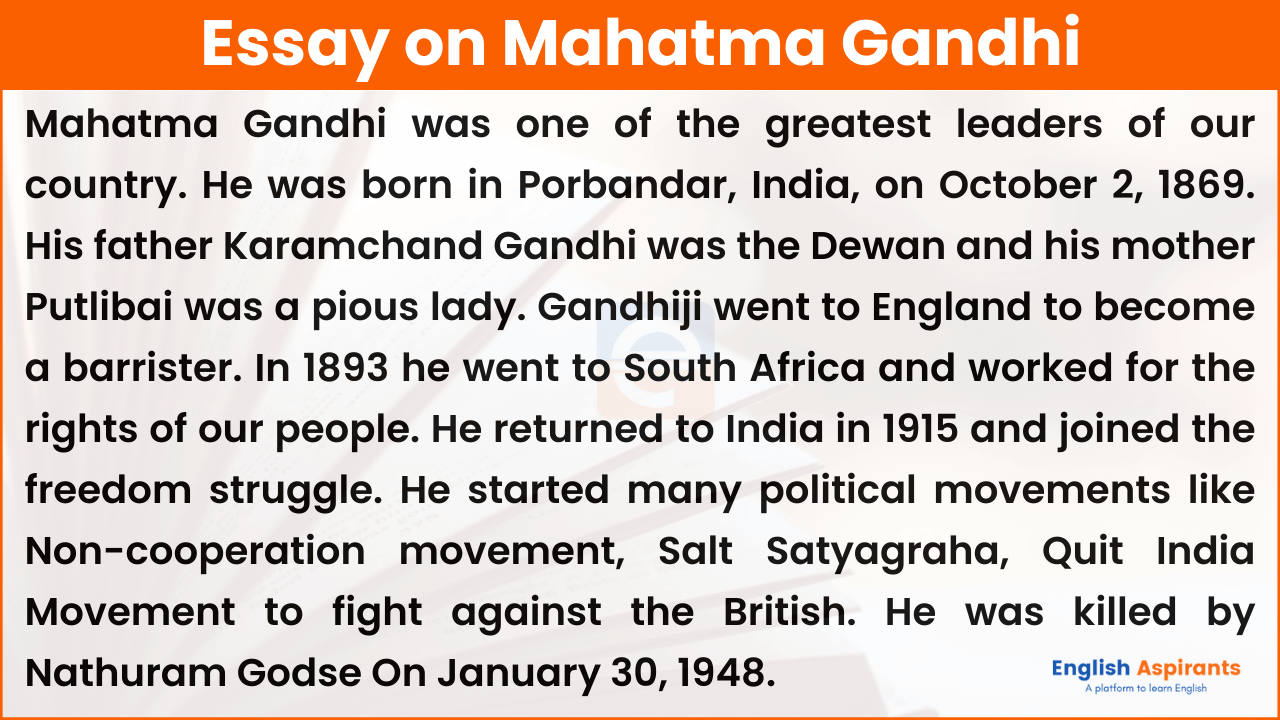
Mahatma Gandhi Essay in English 150 Words
Mahatma Gandhi was a great leader. His full name was Mohandas and Gandhi. He was born on October 2, 1869 at Porbandar. His father was a Diwan. He was an average student. He went to England and returned as a barrister.
In South Africa, Gandhiji saw the bad condition of the Indians. There he raised his voice against it and organised a movement.
In India, he started the non-cooperation and Satyagraha movements to fight against the British Government. He went to jail many times. He wanted Hindu-Muslim unity. In 1947, he got freedom for us.
Gandhiji was a great social reformer. He worked for Dalits and lower-class people. He lived a very simple life. He wanted peace. He believed in Ahimsa.
On January 30, 1948, he was shot dead. We call him ‘Bapu’ out of love and respect. He is the Father of the Nation.
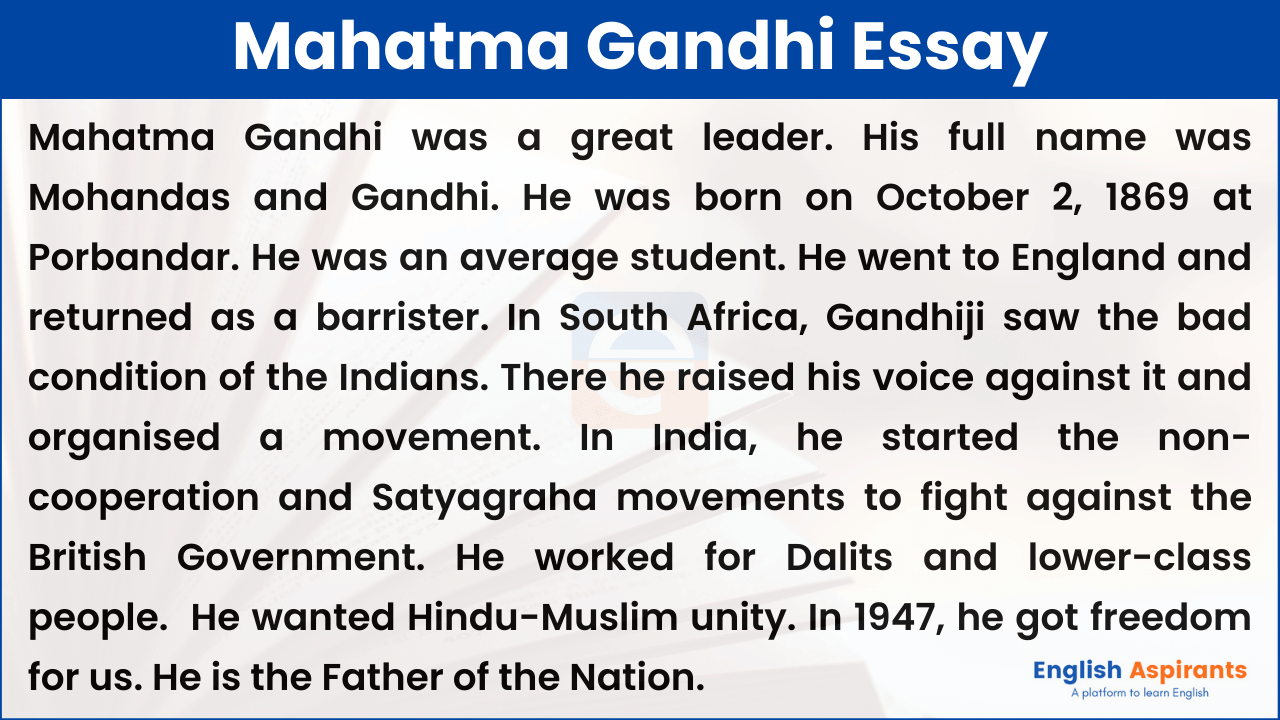
Also Read: 10 Lines on Mahatma Gandhi
Essay on Mahatma Gandhi 200-250 Words
Mohandas Karamchand Gandhi, popularly known as Mahatma Gandhi was an Indian lawyer, freedom activist, and politician. Gandhiji was born on October 2, 1869 at Porbandar, Gujarat. His father Karamchand Gandhi was the Chief Minister (diwan) of Porbandar state. His mother Putlibai was a religious woman.
He went to England to study law at the age of 18 years. After his return to India, he started a practice as a lawyer in the Bombay High Court. He went to South Africa and started practicing law. There he protested against the injustice and harsh treatment of the white people towards the native Africans and Indians.
He returned to India in 1915 and started to take interest in politics. Mahatma Gandhi used the ideals of truth and non-violence as weapons to fight against British colonial rule. He worked for the upliftment of Harijans. He fought against untouchability and worked for Hindu-Muslim unity.
Through his freedom movements like Non-cooperation movement, Khilafat movement, and civil disobedience movement he fought for freedom against the British imperialists. 1942, he launched the Quit India movement to end the British rule. At last, India got freedom in 1947 at his initiative.
People affectionately call him ‘Bapu’ and the ‘Father of the Nation’. He was shot dead in 1948 by the Hindu fanatic Nathuram Godse. Gandhiji’s life is a true inspiration for all of us.
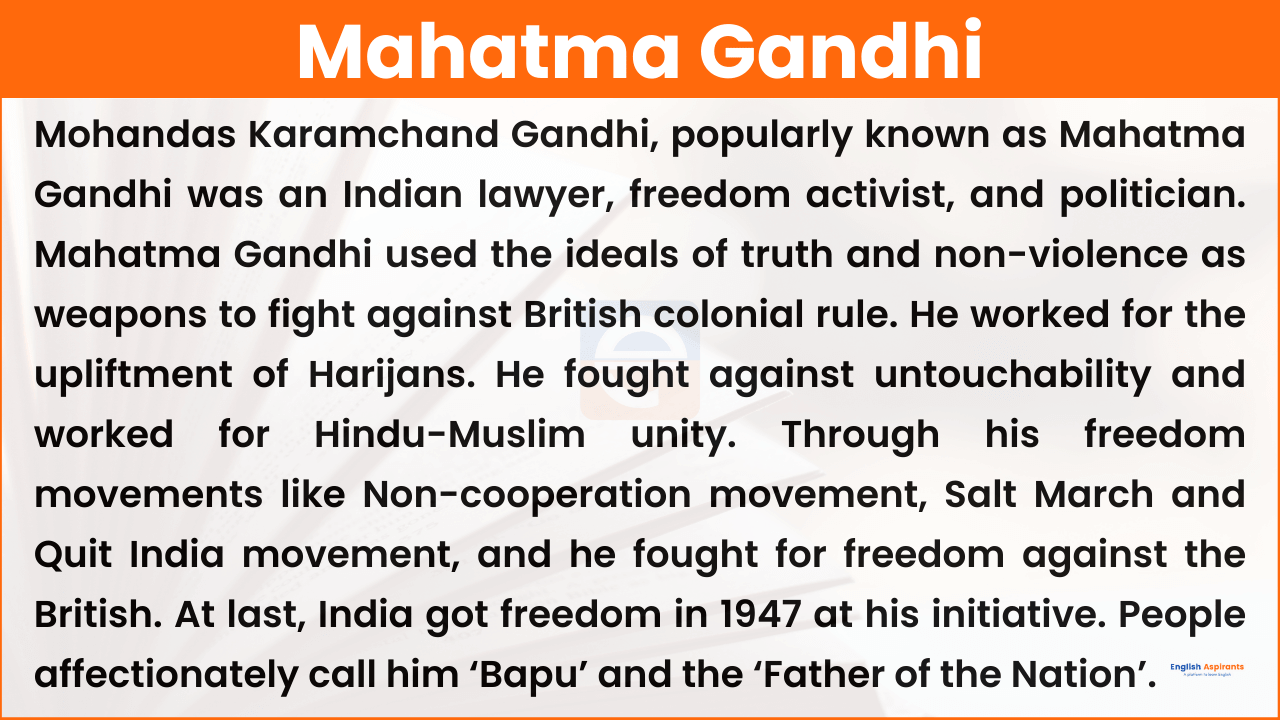
Mahatma Gandhi Essay in English 300 Words
Mahatma Gandhi was born at Porbandar in Gujarat on 2nd October, 1869. His father was the Diwan of the State. His name was Karam Chand Gandhi. Mahatma Gandhi’s full name was Mohan Das Karamchand Gandhi. His mother’s name was Putali Bai. Mahatma Gandhi went to school first at Porbandar then at Rajkot. Even as a child, Mahatma never told a lie. He passed his Matric examination at the age of 18.
Mohan Das was married to Kasturba at the age of thirteen. Mahatma Gandhi was sent to England to study law and became a Barrister. He lived a very simple life even in England. After getting his law degree, he returned to India.
Mr. Gandhi started his law practice. He went to South Africa in the course of a law suit. He saw the condition of the Indians living there. They were treated very badly by the white men. They were not allowed to travel in 1st class on the trains, also not allowed to enter certain localities, clubs, and so on. Once when Gandhiji was travelling in the 1st class compartment of the train, he was beaten and thrown out of the train. Then Mahatma decided to unite all Indians and started the Non-violence and Satyagrah Movement. In no time, the Movement picked up.
Mahatma Gandhi returned to India and joined Indian National Congress. He started the Non-violence, Non-cooperation Movements here also. He travelled all over India, especially the rural India to see the conditions of the poor.
Mahatma Gandhi started Satyagrah Movement to oppose the Rowlatt Act and there was the shoot-out at Jalian-Wala-Bagh. The Act was drawn after many people were killed. He then started the Salt Satyagraha and Quit India Movements. And finally, Gandhiji won freedom for us. India became free on 15th August, 1947. He is called as “Father of the Nation”. Unfortunately, Gandhiji was shot on 30 January 1948 by a Hindu extremist Nathuram Godse.
Also Read: Gandhi Jayanti Speech 10 Lines
Mahatma Gandhi Essay in English 500 Words
Introduction:.
Mohandas Karamchand Gandhi, popularly known as Mahatma Gandhi was a politician, social activist, writer, and leader of the Indian national movement. He is a figure known all over the world. His name is a household word in India, rather, in all the world round. His creed of non-violence has placed him on the same par with Buddha, Sri Chaitanya, and Jesus Christ.
Family & Education:
Mahatma Gandhi was born in the small town of Porbandar in the Kathiwad state on October 2, 1869. His father Karamchand Gandhi was the prime minister of Rajkot State and his mother Putlibai was a pious lady. Her influence shaped the future life of Mahatma Gandhi.
He was sent to school at a very early age, but he was not a very bright student. After his Matriculation Examination, he went to England to study law and returned home as a barrister. He began to practice law in Bombay but he was not very successful.
Life in South Africa:
In 1893 Gandhiji went to South Africa in connection with a case. He found his own countrymen treated with contempt by the whites. Gandhiji started satyagraha against this color hated. It was a non-violent protest, yet hundreds were beaten up and thousands were sent to jail. But Gandhiji did not buzz an inch from his faith in truth and non-violence and at last, he succeeded in his mission. He was awarded the title of Mahatma.
Fight for India’s Independence:
In 1915 Gandhiji came back to India after twenty long years in South Africa. He joined the Indian National congress and championed the cause of India’s freedom movement. He asked people to unite for the cause of freedom. He used the weapons of truth and non-violence to fight against the mighty British.
The horrible massacre at Jalianwalabag in Punjab touched him and he resolved to face the brute force of the British Government with moral force. In 1920 he launched the Non-cooperation movement to oppose British rule in India.
He led the famous Dandi March on 12th March 1930. This march was meant to break the salt law. And as a result of this, the British rule in India had already started shaking and he had to go to London for a Round Table Conference in 1931. But this Conference proved abortive and the country was about to give a death blow to the foreign rule.
In 1942 Gandhiji launched his final bout for freedom. He started the ‘Quit India’ movement. At last, the British Government had to quit India in 1947, and India was declared a free country on August 15, 1947.
Social Works:
Mahatma Gandhi was a social activist who fought against the evils of society. He found the Satyagraha Ashram on the banks of the Sabarmati river in Gujarat. He preached against untouchability and worked for Hindu-Muslim unity. He fought tirelessly for the rights of Harijans.
Conclusion:
Mahatma Gandhi, the father of the nation was a generous, god-loving, and peace-loving person. But unfortunately, he was assassinated by Nathuram Godse on 30th January 1948 at the age of 78. To commemorate Gandhiji’s birth anniversary Gandhi Jayanti is celebrated every year on October 2. Gandhiji’s teachings and ideologies will continue to enlighten and encourage us in the future.
Read More: 1. Essay on Swami Vivekananda 2. Essay on Subhash Chandra Bose 3. Essay on Mother Teresa 4. Essay on APJ Abdul Kalam 5. Essay on Sarvepalli Radhakrishnan
Related Posts
Apj abdul kalam essay in english | 100, 200, 300, 500 words, blood donation essay in english | 150, 200, 300 words, my mother essay in english 10 lines [5 sets], essay on mother teresa in english for students [300 words], leave a comment cancel reply.
Your email address will not be published. Required fields are marked *
Save my name, email, and website in this browser for the next time I comment.
- History Classics
- Your Profile
- Find History on Facebook (Opens in a new window)
- Find History on Twitter (Opens in a new window)
- Find History on YouTube (Opens in a new window)
- Find History on Instagram (Opens in a new window)
- Find History on TikTok (Opens in a new window)
- This Day In History
- History Podcasts
- History Vault
Mahatma Gandhi
By: History.com Editors
Updated: June 6, 2019 | Original: July 30, 2010

Revered the world over for his nonviolent philosophy of passive resistance, Mohandas Karamchand Gandhi was known to his many followers as Mahatma, or “the great-souled one.” He began his activism as an Indian immigrant in South Africa in the early 1900s, and in the years following World War I became the leading figure in India’s struggle to gain independence from Great Britain. Known for his ascetic lifestyle–he often dressed only in a loincloth and shawl–and devout Hindu faith, Gandhi was imprisoned several times during his pursuit of non-cooperation, and undertook a number of hunger strikes to protest the oppression of India’s poorest classes, among other injustices. After Partition in 1947, he continued to work toward peace between Hindus and Muslims. Gandhi was shot to death in Delhi in January 1948 by a Hindu fundamentalist.
Mohandas Karamchand Gandhi was born on October 2, 1869, at Porbandar, in the present-day Indian state of Gujarat. His father was the dewan (chief minister) of Porbandar; his deeply religious mother was a devoted practitioner of Vaishnavism (worship of the Hindu god Vishnu), influenced by Jainism, an ascetic religion governed by tenets of self-discipline and nonviolence. At the age of 19, Mohandas left home to study law in London at the Inner Temple, one of the city’s four law colleges. Upon returning to India in mid-1891, he set up a law practice in Bombay, but met with little success. He soon accepted a position with an Indian firm that sent him to its office in South Africa. Along with his wife, Kasturbai, and their children, Gandhi remained in South Africa for nearly 20 years.
Did you know? In the famous Salt March of April-May 1930, thousands of Indians followed Gandhi from Ahmadabad to the Arabian Sea. The march resulted in the arrest of nearly 60,000 people, including Gandhi himself.
Gandhi was appalled by the discrimination he experienced as an Indian immigrant in South Africa. When a European magistrate in Durban asked him to take off his turban, he refused and left the courtroom. On a train voyage to Pretoria, he was thrown out of a first-class railway compartment and beaten up by a white stagecoach driver after refusing to give up his seat for a European passenger. That train journey served as a turning point for Gandhi, and he soon began developing and teaching the concept of satyagraha (“truth and firmness”), or passive resistance, as a way of non-cooperation with authorities.
The Birth of Passive Resistance
In 1906, after the Transvaal government passed an ordinance regarding the registration of its Indian population, Gandhi led a campaign of civil disobedience that would last for the next eight years. During its final phase in 1913, hundreds of Indians living in South Africa, including women, went to jail, and thousands of striking Indian miners were imprisoned, flogged and even shot. Finally, under pressure from the British and Indian governments, the government of South Africa accepted a compromise negotiated by Gandhi and General Jan Christian Smuts, which included important concessions such as the recognition of Indian marriages and the abolition of the existing poll tax for Indians.
In July 1914, Gandhi left South Africa to return to India. He supported the British war effort in World War I but remained critical of colonial authorities for measures he felt were unjust. In 1919, Gandhi launched an organized campaign of passive resistance in response to Parliament’s passage of the Rowlatt Acts, which gave colonial authorities emergency powers to suppress subversive activities. He backed off after violence broke out–including the massacre by British-led soldiers of some 400 Indians attending a meeting at Amritsar–but only temporarily, and by 1920 he was the most visible figure in the movement for Indian independence.
Leader of a Movement
As part of his nonviolent non-cooperation campaign for home rule, Gandhi stressed the importance of economic independence for India. He particularly advocated the manufacture of khaddar, or homespun cloth, in order to replace imported textiles from Britain. Gandhi’s eloquence and embrace of an ascetic lifestyle based on prayer, fasting and meditation earned him the reverence of his followers, who called him Mahatma (Sanskrit for “the great-souled one”). Invested with all the authority of the Indian National Congress (INC or Congress Party), Gandhi turned the independence movement into a massive organization, leading boycotts of British manufacturers and institutions representing British influence in India, including legislatures and schools.
After sporadic violence broke out, Gandhi announced the end of the resistance movement, to the dismay of his followers. British authorities arrested Gandhi in March 1922 and tried him for sedition; he was sentenced to six years in prison but was released in 1924 after undergoing an operation for appendicitis. He refrained from active participation in politics for the next several years, but in 1930 launched a new civil disobedience campaign against the colonial government’s tax on salt, which greatly affected Indian’s poorest citizens.
A Divided Movement
In 1931, after British authorities made some concessions, Gandhi again called off the resistance movement and agreed to represent the Congress Party at the Round Table Conference in London. Meanwhile, some of his party colleagues–particularly Mohammed Ali Jinnah, a leading voice for India’s Muslim minority–grew frustrated with Gandhi’s methods, and what they saw as a lack of concrete gains. Arrested upon his return by a newly aggressive colonial government, Gandhi began a series of hunger strikes in protest of the treatment of India’s so-called “untouchables” (the poorer classes), whom he renamed Harijans, or “children of God.” The fasting caused an uproar among his followers and resulted in swift reforms by the Hindu community and the government.
In 1934, Gandhi announced his retirement from politics in, as well as his resignation from the Congress Party, in order to concentrate his efforts on working within rural communities. Drawn back into the political fray by the outbreak of World War II , Gandhi again took control of the INC, demanding a British withdrawal from India in return for Indian cooperation with the war effort. Instead, British forces imprisoned the entire Congress leadership, bringing Anglo-Indian relations to a new low point.
Partition and Death of Gandhi
After the Labor Party took power in Britain in 1947, negotiations over Indian home rule began between the British, the Congress Party and the Muslim League (now led by Jinnah). Later that year, Britain granted India its independence but split the country into two dominions: India and Pakistan. Gandhi strongly opposed Partition, but he agreed to it in hopes that after independence Hindus and Muslims could achieve peace internally. Amid the massive riots that followed Partition, Gandhi urged Hindus and Muslims to live peacefully together, and undertook a hunger strike until riots in Calcutta ceased.
In January 1948, Gandhi carried out yet another fast, this time to bring about peace in the city of Delhi. On January 30, 12 days after that fast ended, Gandhi was on his way to an evening prayer meeting in Delhi when he was shot to death by Nathuram Godse, a Hindu fanatic enraged by Mahatma’s efforts to negotiate with Jinnah and other Muslims. The next day, roughly 1 million people followed the procession as Gandhi’s body was carried in state through the streets of the city and cremated on the banks of the holy Jumna River.

Sign up for Inside History
Get HISTORY’s most fascinating stories delivered to your inbox three times a week.
By submitting your information, you agree to receive emails from HISTORY and A+E Networks. You can opt out at any time. You must be 16 years or older and a resident of the United States.
More details : Privacy Notice | Terms of Use | Contact Us
More From Forbes
Mahatma gandhi at 150: lessons on leadership.
- Share to Facebook
- Share to Twitter
- Share to Linkedin
Today, October 2, marks the 150 th anniversary of the birth of Mahatma Gandhi. Around the world, Gandhi’s legacy of non-violence and as the father of India’s Independence Movement is being commemorated and analyzed for relevance in our increasingly turbulent times. Gandhi became the role model for the most successful political movement leaders of the 20th century – from Martin Luther King to Lech Walesa, Cesar Chavez and Nelson Mandela.
Had he come of age today, Gandhi might have branded himself as a “social entrepreneur”. In reality, few social entrepreneurs have achieved anywhere near the scale of impact that Gandhi was able to. But the comparison is apt, as Gandhi was never a head of state or government, but instead, the head of a private organization - the Indian National Congress, that, along with its many partners, mobilized an incredibly diverse and complex peoples into a united movement against British imperialism. He led first and foremost by understanding the diversity of India and its people – economically, culturally, religiously, and deeply integrating that diversity into the Independence movement. He further integrated himself into the movement by dedicating his life to the cause, living as much among the people as possible, and actually risking death many times for the cause. While there may never be another Gandhi, there is no reason that today’s committed social entrepreneurs can’t embrace their own version of Gandhi’s personal and political leadership commitment.
Arguably, Gandhi’s greatest leadership trait was his ability to visualize the qualities of a successful, post-Independence Indian nation, and maintain a life-long focus on the four intertwined challenges that he believed must be collectively addressed for India to achieve success as a nation. The four challenges, or goals, as articulated by Ramchandra Guha in his book, “ Gandhi, The Years That Changed The World ”; were: to free India from British occupation, to end untouchability, to improve relations between Hindus and Muslims, and to make India into a self-reliant nation – economically and socially. Gandhi aligned most of the social movements he led around these four goals - starting with his work in South Africa and continuing until his death. He believed firmly that without addressing all four challenges simultaneously, India could not acquire independence and become a successful nation. Without communal harmony between Hindus and Muslims, or between upper caste and lower caste Hindu’s, for example, Gandhi did not believe India would ever achieve its potential.
A second element of Gandhi’s leadership was his lifelong commitment to achieving that intertwined vision of a successful Indian nation. Starting in the 1890’s with his work in South Africa until his death in 1948, Gandhi wrote, mobilized and preached about the same goals of freedom, inclusion, harmony, diversity and empowerment. Today, few of the most committed social entrepreneurs have the energy to stay engaged on the same set of issues for 50-60 years. Dr. Muhammad Yunus of the Grameen Bank has been one, very notable exception.
Mahatma Gandhi
Gandhi’s most well-known, and most-studied, leadership trait was his willingness to live like the majority of Indians that he sought to help, and his exhortation that all Indians “be the change they wish to see in this world”. It seems obvious, but in a day and age when NGO leaders are in Davos, London and New York as much as they are in the villages, and when NGO salaries remain a hot topic, Gandhi’s ability to live comfortably among villagers and the urban poor – to be the change he wished to see, brought him the credibility, trust and intellectual understanding needed to lead India’s independence movement. While today’s social entrepreneurs also have compelling visions for change, they are often unable to separate themselves from the global elite to which they have historically belonged. And fairly or unfairly, many for-profit entrepreneurs and social enterprises are perceived as seeking to profit off the backs of the world’s poor, and never gain credibility, even when their primary objective and motivation is to improve the human condition.
Gandhi’s least studied leadership trait was his ability to use the fast as a social and political weapon. Over the course of his life time, Gandhi fasted 14 times for social, religious or political purposes – a skill he mastered through personal practice. He would fast for personal penance and to build his own capacity for sacrifice, ahimsa and brahmacharya.
Today in business and entrepreneurship, we often talk about core competency and disruptive innovation. Entrepreneurs are told to develop a product or service that is difficult to compete against - technically complex, different from the past and very difficult to replicate by others.
Gandhi’s ability to fast for social change was his core competency. It took him many years to train his body and mind to function without food, and only later did he use the fast as a political weapon. No one else could do it and there was no answer for it – from anyone. The British never had an effective response, nor did angry Indian communal rioters. In each case, Gandhi’s fasts brought capitulation to his wishes, because anything was a more acceptable solution than to allow Gandhi’s death. It was a great innovation in social movements that, except for Cesar Chavez’s fasts for farm workers in California, has never been remotely replicated.
The elements of Gandhi’s leadership model remain relevant today. Whether a leader is seeking to end sexual discrimination, eradicate HIV/AIDS or legislate a jobs program, they will need their own version of Gandhi’s leadership model - re-imagined in their own vision. In the age of the #MeToo movement, for example, leaders for gender equality and an end to sexual harassment must attack the intertwined issues of religion, family structure, sexism, and the transformation of labor markets. Similarly, to eradicate the HIV virus will require new drugs and vaccines, but will also transformation in the health care system, cultural norms around sexuality, building rural health delivery programs and many other things. These will take a life time to achieve and require leaders with great credibility and trust amongst the communities they are seeking to help and change. Gandhi was able to maintain the support of India’s upper caste Hindu’s and industrialists while maintaining the trust of the rural and poor.
What’s missing today is the 2019 version of the fast. We have major global crises in areas like climate change and forced migration, but no leaders who have yet found tools, like Gandhi’s fast-till-death, to push public opinion and government leaders to action. Our greatest commemoration of Gandhi’s life may be to find the tools that lead to large-scale change non-violently, but forcibly in the same manner that he did so effectively.
- Editorial Standards
- Reprints & Permissions
Mahatma Gandhi’s Leadership Report
Executive summary, introduction, gandhi’s leadership style and behaviour, gandhi’s transformative and transactional leadership, gandhi’s use of power, reference list.
Mahatma Gandhi is perhaps the greatest leader of the millennium. His leadership pioneered peaceful and non-violent civil disobedience and set the stage for the development of human rights. Ghandi used transformative, people-centred, charismatic and servant leadership to lobby for India’s independence from the British. He was particularly a good power manager and never rose above his followers.
He voluntarily decided to be poor, fasted for days as a way of passing his disapproval and even dressed in the same way as his followers. Gandhi set a legacy that has been instrumental in the fight for freedom. This report discusses Gandhi’s leadership style and behaviour, and his power management skills.
Mahatma Gandhi was a great leader. When one reads his many famous quotes, there is no doubt that they were informed by an in-depth understanding of leadership (Nath 2010). Gandhi is no doubt among the greatest political personalities who lived during the twentieth century. His influence is far-reaching and he is credited to be the inspiration behind the leaders of the American Civil Rights Movement.
“Gandhi was born in Gujarat on October 2 nd 1869, and was assassinated on January 30 th 1948” (Yates 2013, p. 1). Mahatma was a charismatic leader, who was analytical and deliberate in his behaviour. A product of the colonial era Gandhi was interestingly inspired by the Bhagavad-Gita, which had been written many years before he was born. He was an orator, a politician, an intellectual and a writer.
He was indubitably a quite complex human being, one who believed in voluntary subordination and simplicity and yet had a strong stand about his vision for a free society. This report is an analysis of the behaviour and leadership style of Ghandi, the transactional and transformative aspects of his leadership and the way he used the power he had to help India gain Independence.
According to Dalglish and Miller (2010, p. 94), “A people-centred leader stresses concern for people”. Gandhi was such a leader. His people-minded leadership is confirmed by his ahimsa principle. Gandhi used this principle to urge his followers to love all humans regardless of whether they are their friends or enemies. The ahimsa principle was informed by his belief in non-violence ( Gandhis Non-violence n.d.).
Gandhi not only urged his followers to refrain from physically harming their opponents (the British) but he also urged them to avoid developing ill-will and hatred towards them. Therefore, non-violence was not all about avoiding physically harming the British. Mahatma believed that the colonialists in India needed to be convinced of their injustice and not to be punished ( Gandhis Non-violence n.d.).
It can therefore be argued that Gandhi was focussed on having a virtuous following while protesting against the injustices of the British colonialists. This proves the fact that he was a people-centred leader.
The Satyagraha principle, that was basically an extension of ahimsa principle, was also instrumental in the fight against colonialism by the British. It means ‘soul-force’ and it advocated for a firm stand on the ideals that the Indian populace held, but without ill-will and hatred. Its form in the public domain was civil disobedience as well as failure to cooperate with evil.
The former involved breaking unjust laws while the latter involved non-compliance with unjust systems. “The Salt March of 1930 was one of Gandhi’s greatest successes in civil disobedience. Salt was necessary to the life of Indian farmers’ cattle, and the British monopoly on salt production had led to massive taxes on the vital substance” ( Gandhis Non-violence n.d., p. 1).
After Gandhi broke the British Salt Law, a myriad of Indians followed his example and broke the law too. It also encouraged them to break other oppressive laws. This is proof of people centred leadership because Gandhi empowered the masses to reject oppression through civil disobedience. The second element of Satyagraha did not involve breaking laws.
They accomplished it by avoiding British products, getting out of schools established by the British and so forth. This led to halting of production systems that were set up by the British ( Gandhis Non-violence n.d.).
“Research showed that people centred leadership is not consistently related to productivity but does tend to enhance group satisfaction and cohesiveness” (Dalglish & Miller 2010, p. 94). Gandhi had the potential to move and inspire masses in India. He was particularly good at empowering people, making common Indians engage in the struggle for independence and making them realize the progress they had made after each protest.
He toured the whole of India and personally led all major movements in the country, repeatedly holding public meetings with his supporters (Gupta 2008). He was always accessible to others and thus they became connected to him and shared his vision, making the whole of India resistant to British oppression.
Transformative leadership
Transformative leadership theory has evolved with time but is remains an invaluable part of contemporary leadership literature. Dalglish and Miller (2010) describe transformational leadership as a style of leadership that seeks to change the current state of affairs by accomplishing three main tasks. Firstly, the leader connects with his followers and instils in them a sense of a greater purpose.
Secondly, the leader frames the issues at hand such that they relate with both the followers’ and leader’s values and vision (Pillai 2011). Lastly, the leader ensures that he/she upholds the morals necessary for the achievement of the vision, often at a level much higher than that of his/her followers.
This way, the followers strive to emulate the leader and this leads to change of status quo (Dalglish & Miller 2010). Gandhi has been cited in various literatures as the embodiment of transformative leadership (McDowelle 2009). This section investigates the transformative aspects of Mahatma Gandhi’s leadership.
Gandhi was imprisoned for a long period, and fasted for so long that his health was threatened. He intended to use this as a way of sending a message to the Indian populace and the colonialists. He created a moral vision that was transformative in nature and “based on what he called truth” (McDowelle 2009, p. 1).
His way of protesting therefore made him win the feelings and emotions of his followers, a key component of transformational leadership (Lowe, Kroeck & Sivasubramaniam 1996).
Aluya (2009) describes Mahatma as a transformational and a spiritual leader. “His leadership style transcended the polarization of ethnic or religious boundaries and was regarded as the father of the Indian Nation” (Aluya 2009, p. 4).
Mahatma’s leadership style that advocated for non-violence was recently recognized by the declaration of October second, his “birthday, as the International Day of Non-Violence” (Aluya, 2009, p. 4) by the UN (United Nations). It is important to note that transformative leaders share many attributes with charismatic leaders (Harith 2012), and thus Mahatma was a charismatic leader as well.
Transactional leadership
Dalglish and Miller (2010, p. 139) define transactional leadership as the form of leadership that “is characterized by leaders and followers being in an exchange relationship”. Transactional leadership is transitory in nature and thus the parties may part ways after the completion of the transaction.
This is the main downside of transactional leadership (Dalglish & Miller 2010). Gandhi’s leadership can be viewed to have a transaction that is not so obvious to discern. Indian masses needed independence from the British (Palshikar 2008) and Gandhi was in the process of self discovery and self development.
After being an non-practicing lawyer for some time, Gandhi had made a resolution to follow a higher calling; ensuring that people get justice through his leadership. It is therefore arguable that he needed the support of the Indian populace, after coming back from South Africa, if he was to fulfil his dream of a just society.
Mahatma achieved transactional leadership after winning the hearts of the populace and the attention of the British through imprisonment and fasting. He however delivered his part of the exchange much later; after India gained independence from Britain (Aarons 2007).
Transformational leaders get their power from influencing and inspiring the masses to believe in the same things they believe in, and their ability to stimulate the populace to act in a certain way in order to realize a common goal (Lai 2011).
Gandhi was a transformational leader and therefore he gained his power by empowering the people to resist oppressive laws and share a common vision of an India independent from British colonialism.
While the majority of leaders elevate themselves with symbols of power, Gandhi was a symbol of the people he served (Barnabas & Clifford 2012). Gandhi dressed in loin cloth like his followers and voluntarily accepted to be poor in order to serve people better.
Although he had power in the way he could control Indian masses, Gandhi was more of a people’s servant than a power-bearer. Gandhi can therefore be described as a servant leader who understood the need for voluntary subordination in service (Barnabas & Clifford 2012).
Gandhi used the power of his vision as the guiding principle of his protests. “He could write the most complex intellectual work to be sure his point was understood. Yet, he could express the feelings of his followers in the most simple and eloquent ways” (Yates 2013, p. 3). He indubitably had great intellectual power, which he did not show off to the British.
He instead used his intellectual power to influence people in order to rally support for rejection of oppression and colonialism. An example of how he appropriately used his intellectual power is when he collected a handful of salt from the beach, an action that was against the Salt Law and an expression of freedom from oppressive laws, and that was meant to show his disapproval of the aforementioned law.
This act was copies by many Indians and led to imprisonment of many. The protest against the Salt Law is however credited as a major step towards the independence of India (Yates 2013).
Gandhi also drew power from his disregard for himself and fearlessness. He singlehandedly halted slaughter in Bengal by meeting combatants without fearing for his life. This meeting was preceded by a fearless fasting period. It is important to note that his use of non-violence and disregard for himself were his greatest weapons. Gandhi also drew power from the aspects of transformative leadership that he exhibited.
This power is described by Shields (2010, p. 567) as “the ability of the leader to reach the souls of others in a fashion which raises human consciousness, builds meanings, and inspires human intent that is the source of power”. After gaining such power, Gandhi used servant leadership to lead his followers and thus he never acted in a way suggesting that he took credit for beginning the revolution.
His way of disobedience had a great influence on leaders all over the world. Some of the leaders who got their inspiration from Gandhi include Martin Luther King and his counterpart in American Civil Rights Movement, Malcolm X (Yates 2013).
From the above discussion, it is apparent that Mahatma’s leadership style can be summarized into four leadership styles. These are transformational leadership, people-oriented leadership, servant leadership and charismatic leadership. Gandhi was a special and remarkable individual and thus his leadership was more or less a legacy.
His disregard for himself in the fight for freedom and use of non-violence transformed civil disobedience and influenced civil movements throughout the world. He was commendably the inspiration behind Martin Luther King’s advocacy for dialogue and peaceful protests during the American Civil Rights Movement that took place in the mid-twentieth century.
Among the most interesting things about Gandhi was the way he used the power that had been bestowed upon him by his followers. Gandhi lived like one of them and interacted with them freely.
He never misused the power he had over the masses and only used it to stage civil disobedience against oppressive laws and colonization. Gandhi frequently fasted for days as a way of showing disapproval of British laws and behaviour. He was ready to die for his country that at one time he faced a battalion alone. He died by assassination and became an inspiration to many people around the world.
Aarons, G. 2007, ‘Transformational and Transactional Leadership: Association With Attitudes Towards Evidence-Based Practice’, Psychiatric Services , vol. 57, no. 8, pp. 1162-1169, National Centre for Biotechnology Information. Web.
Aluya, D. 2009, Complexity of Leadership, Organizations and the Real Estate Industry , Author House, Bloomington, IN.
Barnabas, A., Clifford, P. 2012, ‘ Mahatma Gandhi – An Indian Model of Servant Leadership ’, International Journal of Leadership Studies , vol. 7, no. 2, pp. 133-154. Web.
Dalglish, C. & Miller, P. 2010, Leadership: Understanding its Global Impact , Tilde University Press, Australia. Gandhi’s Non-Violence . Web.
Gupta, A. 2008, Gandhi: An Exemplary Leader. Web.
Harith, S. 2012, Different Styles of Leadership . Web.
Lai, A. 2011, ‘Transformational-Transactional Leadership Theory’, AHS Capstone. Projects , Paper 17. Web.
Lowe, K., Kroeck, K. & Sivasubramaniam, N. 1996. ‘ Effectiveness correlates of transformational and transactional leadership: A meta-analytic review of the MLQ literature ’, The Leadership Quarterly , vol. 7, no. 3, pp. 385-415. Web.
McDowelle, J. 2009, ‘A Contemporary Consideration of Transformative Leadership’, Journal of Curriculum and Instruction , vol. 3, no. 2, pp. 1-5, East Carolina University. Web.
Nath, S. 2010, Mahatma Gandhi’s Leadership Styles in Management . Web.
Palshikar, K. 2008, Charismatic Leadership . Web.
Pillai, M. 2011, 5 Effective leadership styles . Web.
Shields, C. 2010, ‘Transformative Leadership: Working for Equity in Diverse Contexts’, Educational Administration Quarterly , vol. 46, no. 4, pp. 558-589, Sage Journals. Web.
Yates, M. 2013, Gandhi . Web.
- Chicago (A-D)
- Chicago (N-B)
IvyPanda. (2024, February 15). Mahatma Gandhi’s Leadership. https://ivypanda.com/essays/mahatma-gandhis-leadership/
"Mahatma Gandhi’s Leadership." IvyPanda , 15 Feb. 2024, ivypanda.com/essays/mahatma-gandhis-leadership/.
IvyPanda . (2024) 'Mahatma Gandhi’s Leadership'. 15 February.
IvyPanda . 2024. "Mahatma Gandhi’s Leadership." February 15, 2024. https://ivypanda.com/essays/mahatma-gandhis-leadership/.
1. IvyPanda . "Mahatma Gandhi’s Leadership." February 15, 2024. https://ivypanda.com/essays/mahatma-gandhis-leadership/.
Bibliography
IvyPanda . "Mahatma Gandhi’s Leadership." February 15, 2024. https://ivypanda.com/essays/mahatma-gandhis-leadership/.
- Critical Comparative Book Review: Mahatma Gandhi: Nonviolent Liberator: A Biography and The Life of Mahatma Gandhi
- Mahatma Gandhi: What One Should Know
- Mahatma Gandhi: Strengths and Weaknesses
- Mahatma Gandhi's Salt Walk and Civil Disobedience
- Mahatma Gandhi’s Leader Style
- Mahatma Gandhi: A Leader's Transformation
- Gandhism and Its Significance in India and World
- Comparison of Gandhi’s and Hitler’s Leadership
- Mohandus Gandhi’s leadership
- Oprah Winfrey and Mahatma Gandhi as Transformational Leaders
- Sheikh Zayed bin Sultan Al Nahyan: The Great Man
- Indira Gandhi: Autocratic Leader of India
- Sir Winston Leonard Spencer-Churchill
- Life of Abdur Rahman
- Adolf Hitler: From Patriotism to Racism
Talk to our experts
1800-120-456-456
- Mahatma Gandhi Essay

Important Essay on Mahatma Gandhi for Students in English
Mohandas Karamchand Gandhi, often called the 'Father of the Nation' , was a leader who fought for India's freedom from British rule. He believed in non-violence. Every year on October 2nd, Mahatma Gandhi's birthday is celebrated as Gandhi Jayanti to honor his efforts in freeing India.
English Essay on Mahatma Gandhi
Rabindranath Tagore was the first to call Gandhiji 'Mahatma,' which means 'Great Soul' in Sanskrit. His wise ideas and beliefs led people to respect and call him 'Mahatma Gandhi.' His dedication to the country and efforts to turn his ideas into reality make Indians around the world very proud of him .
According to Mahatma Gandhi’s biography, he was born on October 2, 1869 , in Porbandar, a coastal town in the present-day Indian state of Gujarat. He grew up in a Hindu family and ate basic vegetarian meals. His dad, Karamchand Uttamchand Gandhi, was an important leader in Porbandar State. In South Africa, he was the first to lead a peaceful protest movement, setting him apart from other demonstrators. Mahatma Gandhi also introduced the idea of Satyagraha, a nonviolent approach to opposing unfairness. He devoted 20 years of his life to battling discrimination in South Africa.
His idea of 'Ahimsa,' which means not hurting anyone, was widely admired and followed by many influential people worldwide. He became an indomitable figure who couldn't be defeated in any situation. Mahatma Gandhi initiated the 'Khadi Movement' to encourage the use of fabrics like khadi or jute. This movement was a crucial part of the larger 'Non-co-operation Movement,' which advocated for Indian goods and discouraged foreign ones. Gandhi strongly supported agriculture and encouraged people to engage in farming. He inspired Indians to embrace manual labor and emphasized self-reliance, urging them to provide for their needs and lead simple lives. He began weaving cotton clothes using the Charkha to reduce dependence on foreign goods and promote Swadeshi products among Indians.
During the fight for India's freedom, Gandhiji faced imprisonment several times along with his followers, but his main goal was always the freedom of his motherland. Even when he was in prison, he never chose the path of violence.
Mahatma Gandhi made significant contributions to various social issues. His efforts against 'untouchability' while he was in Yerwada Jail, where he went on a hunger strike against this ancient social evil, greatly helped uplift the oppressed community in modern times. He also emphasized the importance of education, cleanliness, health, and equality in society.
These qualities defined him as a person with a great soul and justified his transformation from Gandhi to Mahatma. He led many freedom movements, including the "Quit India Movement," which was highly successful. His death was a huge loss to the forces of peace and democracy, leaving a significant void in the nation's life.
Gopal Krishna Gokhale, a prominent Indian nationalist leader, significantly influenced Mahatma Gandhi's political ideology and leadership approach. Gandhi considered him his political teacher.
Mahatma Gandhi played a crucial role in India's fight for freedom from British rule. His life was dedicated to serving his country and its people, and he became an international symbol of Indian leadership. Even today, he continues to inspire and motivate young people worldwide with his values and principles.
Gandhi Ji was known for his strong sense of discipline. He emphasized the importance of self-discipline in achieving significant goals, a principle he applied in promoting his philosophy of Ahimsa (non-violence). Through his own life, he demonstrated that rigorous discipline can lead to the realization of any objective, provided we remain committed and dedicated. These qualities established him as a revered and respected leader whose influence extends far beyond his lifetime. His ideals continue to resonate not only in India but also around the world.

FAQs on Mahatma Gandhi Essay
1. What were the different movements that Gandhi started in order to bring Independence to India?
In order to bring freedom, Gandhi started the Satyagraha movement in 1919, the non-cooperation movement in 1921, and Civil Disobedience movement in 1930 and Quit India movement in 1942.
2. Who killed Mahatma Gandhi?
A young man named Nathuram Godse killed Mahatma Gandhi when he was going to attend an evening prayer meeting.
3. Why is Gandhi known as the ‘Father of the Nation’?
Mahatma Gandhi is known as the ‘Father of the Nation’ because he laid the true foundation of independent India with his noble ideals and supreme sacrifice.
4. How do we commemorate Mahatma Gandhi’s contribution for our Nation?
His birthday on 2 nd October is celebrated as a National Holiday across the nation in order to commemorate his great contributions and sacrifices for the country’s independence.
5. What are the things we should learn from Mahatma Gandhi?
There are various things one can learn from Gandhiji. The principles that he followed and preached his entire generation and for generations to come are commendable. He believed in ‘Ahimsa’ and taught people how any war in the world can be won through non-violence. To simply state one can learn the following principles from Gandhiji -
Nonviolence,
Respect for elders,

Essay on My Favourite Leader Mahatma Gandhi
Students are often asked to write an essay on My Favourite Leader Mahatma Gandhi in their schools and colleges. And if you’re also looking for the same, we have created 100-word, 250-word, and 500-word essays on the topic.
Let’s take a look…
100 Words Essay on My Favourite Leader Mahatma Gandhi
Introduction.
Mahatma Gandhi, also known as ‘Bapu’, is my favourite leader. Born in Porbandar, Gujarat, he played a crucial role in India’s fight for independence.
Gandhi’s Principles
Gandhi believed in non-violence and truth. His principles of Satyagraha (insistence on truth) and Ahimsa (non-violence) have inspired millions.
Gandhi led India to independence using peaceful methods, setting a unique example of leadership. His simplicity and humility made him a loved leader.
Gandhi’s teachings continue to guide us. He showed that peaceful means can bring about great changes, making him a timeless leader.
250 Words Essay on My Favourite Leader Mahatma Gandhi
Mahatma Gandhi, fondly known as the ‘Father of the Nation’, is my favourite leader. His life and teachings have been an inspiration to millions worldwide, including me. His philosophy of non-violence, truth, and love has had a profound impact on our society and politics.
Gandhi’s Philosophy
Gandhi’s philosophy was rooted in the principle of ‘Satyagraha’, a form of nonviolent resistance. For him, truth was God and non-violence was the means to seek it. He demonstrated that peaceful protests could yield powerful results, a lesson that resonates even in today’s turbulent times.
Leadership Style
Gandhi’s leadership style was unique. He led by example, living a simple life, and practicing what he preached. His ability to empathize with the common man, his insistence on equality and justice, and his commitment to his principles made him a leader par excellence.
Gandhi and Independence
Gandhi played a crucial role in India’s struggle for independence. His non-violent protests, including the Dandi March and the Quit India Movement, shook the foundations of the British Empire. His strategies were instrumental in galvanizing the masses towards a common goal of freedom.
Mahatma Gandhi’s life and teachings continue to inspire and guide us. His leadership transcends time and geography, making him a universally respected figure. His belief in peace, truth, and non-violence is more relevant today than ever before. In an era of increasing violence and intolerance, Gandhi’s teachings offer a beacon of hope. He remains my favourite leader, a symbol of courage, conviction, and compassion.
500 Words Essay on My Favourite Leader Mahatma Gandhi
Mahatma Gandhi, a name that resonates with peace and non-violence, is my favourite leader. His life and teachings have inspired millions worldwide. Born as Mohandas Karamchand Gandhi on October 2, 1869, he later came to be known as ‘Mahatma’, meaning ‘great soul’. His principles of truth and non-violence have become a beacon of hope and peace, not only for India but for the entire world.
Early Life and Education
Gandhi’s early life was shaped by the influences of his devout Hindu mother and Jain mentors. He was educated in law at University College London. His time in London was a transformative period where he was introduced to the works of philosophers like Henry David Thoreau and Leo Tolstoy, which later influenced his philosophy of non-violence.
Struggle for Indian Independence
Gandhi’s involvement in the Indian struggle for independence began when he returned to India from South Africa, where he had fought against racial discrimination. He employed his philosophy of Satyagraha, or non-violent resistance, as a powerful tool against the British rule. His non-violent civil disobedience, including the Salt March and Quit India Movement, shook the foundations of the British Empire and played a significant role in India’s fight for independence.
The Doctrine of Non-Violence
One of the most defining aspects of Gandhi’s life was his unwavering commitment to non-violence. He believed that violence merely perpetuates more violence, a cycle that can only be broken through peaceful means. His philosophy of non-violence, or Ahimsa, was not just about abstaining from physical violence, but also from harboring violent thoughts. He believed that the path to real freedom lay in winning over the hearts of the oppressors through love and patience.
Gandhi’s legacy extends far beyond the borders of India. His principles have influenced numerous civil rights movements worldwide, including the American Civil Rights Movement led by Martin Luther King Jr. His life and teachings continue to inspire and guide people in their fight against injustice and oppression.
Mahatma Gandhi’s life exemplifies the power of truth, non-violence and perseverance. His belief in the inherent goodness of humanity and his unwavering commitment to his principles make him my favourite leader. His teachings are not merely historical lessons but are relevant even today, guiding us in our quest for peace and justice. As we navigate through the complexities of the modern world, Gandhi’s philosophy serves as a guiding light, reminding us that real change can only come from within and that love and non-violence are the most potent weapons against hatred and injustice.
That’s it! I hope the essay helped you.
If you’re looking for more, here are essays on other interesting topics:
- Essay on My Favourite Leader Jawaharlal Nehru
- Essay on My Favourite Freedom Fighter
- Essay on My Car
Apart from these, you can look at all the essays by clicking here .
Happy studying!
Leave a Reply Cancel reply
Your email address will not be published. Required fields are marked *
Save my name, email, and website in this browser for the next time I comment.
Home — Essay Samples — History — Mahatma Gandhi — An Analysis of the Leadership Style of Mahatma Gandhi
An Analysis of The Leadership Style of Mahatma Gandhi
- Categories: Mahatma Gandhi
About this sample

Words: 421 |
Published: Jan 30, 2024
Words: 421 | Page: 1 | 3 min read
Table of contents
Nonviolent resistance, ability to inspire and mobilize masses, emphasis on moral integrity.
- Mahatma Gandhi - Nonviolent Resistance and Civil Disobedience, https://www.history.com/topics/india/mahatma-gandhi
- Gandhi's Leadership Style: A Comparison with Modern Leadership Styles, https://www.researchgate.net/publication/330378198_Gandhi's_Leadership_Style_A_Comparison_with_Modern_Leadership_Styles
- Mahatma Gandhi: His Influence & Relevance, https://www.insightsonindia.com/2020/10/02/mahatma-gandhi-his-influence-relevance/

Cite this Essay
Let us write you an essay from scratch
- 450+ experts on 30 subjects ready to help
- Custom essay delivered in as few as 3 hours
Get high-quality help

Verified writer
- Expert in: History

+ 120 experts online
By clicking “Check Writers’ Offers”, you agree to our terms of service and privacy policy . We’ll occasionally send you promo and account related email
No need to pay just yet!
Related Essays
1 pages / 564 words
2 pages / 758 words
2 pages / 707 words
5 pages / 2155 words
Remember! This is just a sample.
You can get your custom paper by one of our expert writers.
121 writers online
Still can’t find what you need?
Browse our vast selection of original essay samples, each expertly formatted and styled
Related Essays on Mahatma Gandhi
Mahatma Gandhi, the great Indian leader, is widely known for his perseverance in the face of adversity. His unwavering determination and persistence played a crucial role in bringing about significant social and political change [...]
The great Mahatma Gandhi once stated that a man becomes what he believes himself to be. By continually declaring that a particular task is hard to undertake, the possibility of that becoming a reality is very high. Contrarily, [...]
“A leader is the one who knows the way, goes the way, and shows the way,” by John C. Maxwell (C.Maxwell). Every leader has followers so that he can lead and show them the right direction to achieve the goals. Leadership is a [...]
Mahatma Gandhi, in the book “Selected Political Writings,” claimed that “swaraj” is to be taken to mean the “independence” of a nation or people. In this essay I will discuss the questions of: Why does Gandhi think nations [...]
The well-known and everlasting name, Mahatma Gandhi was a man of hope and determination. He was one of the hundreds of protesters who fought for Indian independence from the British reign and fought for the rights of the poor. [...]
Mohandas .K. Gandhi well known as "Mahatma"(great souled) was the great founder of the Principle of Non-Violence as a political way of life. Gandhi was born on the 2nd October 1869 at Porbandar. He was born into both a political [...]
Related Topics
By clicking “Send”, you agree to our Terms of service and Privacy statement . We will occasionally send you account related emails.
Where do you want us to send this sample?
By clicking “Continue”, you agree to our terms of service and privacy policy.
Be careful. This essay is not unique
This essay was donated by a student and is likely to have been used and submitted before
Download this Sample
Free samples may contain mistakes and not unique parts
Sorry, we could not paraphrase this essay. Our professional writers can rewrite it and get you a unique paper.
Please check your inbox.
We can write you a custom essay that will follow your exact instructions and meet the deadlines. Let's fix your grades together!
Get Your Personalized Essay in 3 Hours or Less!
We use cookies to personalyze your web-site experience. By continuing we’ll assume you board with our cookie policy .
- Instructions Followed To The Letter
- Deadlines Met At Every Stage
- Unique And Plagiarism Free
- Undergraduate
- High School
- Architecture
- American History
- Asian History
- Antique Literature
- American Literature
- Asian Literature
- Classic English Literature
- World Literature
- Creative Writing
- Linguistics
- Criminal Justice
- Legal Issues
- Anthropology
- Archaeology
- Political Science
- World Affairs
- African-American Studies
- East European Studies
- Latin-American Studies
- Native-American Studies
- West European Studies
- Family and Consumer Science
- Social Issues
- Women and Gender Studies
- Social Work
- Natural Sciences
- Pharmacology
- Earth science
- Agriculture
- Agricultural Studies
- Computer Science
- IT Management
- Mathematics
- Investments
- Engineering and Technology
- Engineering
- Aeronautics
- Medicine and Health
- Alternative Medicine
- Communications and Media
- Advertising
- Communication Strategies
- Public Relations
- Educational Theories
- Teacher's Career
- Chicago/Turabian
- Company Analysis
- Education Theories
- Shakespeare
- Canadian Studies
- Food Safety
- Relation of Global Warming and Extreme Weather Condition
- Movie Review
- Admission Essay
- Annotated Bibliography
Application Essay
- Article Critique
- Article Review
- Article Writing
- Book Review
- Business Plan
- Business Proposal
- Capstone Project
- Cover Letter
- Creative Essay
- Dissertation
- Dissertation - Abstract
- Dissertation - Conclusion
- Dissertation - Discussion
- Dissertation - Hypothesis
- Dissertation - Introduction
- Dissertation - Literature
- Dissertation - Methodology
- Dissertation - Results
- GCSE Coursework
- Grant Proposal
- Marketing Plan
- Multiple Choice Quiz
- Personal Statement
- Power Point Presentation
- Power Point Presentation With Speaker Notes
- Questionnaire
- Reaction Paper
- Research Paper
- Research Proposal
- SWOT analysis
- Thesis Paper
- Online Quiz
- Literature Review
- Movie Analysis
- Statistics problem
- Math Problem
- All papers examples
- How It Works
- Money Back Policy
- Terms of Use
- Privacy Policy
- We Are Hiring
Leadership Analysis: Mahatma Gandhi, Essay Example
Pages: 12
Words: 3394
Hire a Writer for Custom Application Essay
Use 10% Off Discount: "custom10" in 1 Click 👇
You are free to use it as an inspiration or a source for your own work.
Introduction
“I suppose leadership at one time meant muscles; but today it means getting along with people.” Spoken from Mahatma Gandhi himself believed that there was more to leadership then brawns but instead through relationships formed with people. Leadership can be defined in several ways however leadership encompasses three central things, influence, their followers, and the common goal of all parties involved. Leadership is viewed from the casting of a collective vision that others want to follow. Mahatma Gandhi is one of the true definitions of a leader. He wasn’t born to be a leader, he was imperfect, but he was authentic. Gandhi became a famous writer, intellectual, gifted orator, and politician that changed the lives of millions. Not only was Gandhi influential to those around him but his power resonated with the likes of Nelson Mandela, Barack Obama, Albert Einstein, and others with his movements for civil rights, freedom, and non-violence.
Throughout this this leadership course the purpose was to show that anyone can be capable of leadership. The leadership styles are the mechanisms adopted by the leader in order to carry out the responsibilities of doing the greater good for others. In many profiles of great leaders most possessed the qualities that weren’t inherent but instead developed and created over times. Their leadership skills were carefully molded and polished over a period of time through experiences that gave them the will and motivation to put aside their ego and become a great leader. Great leaders are not born but instead can be learned and taught how to be an effective leader. Becoming a great leaders is a never-ending process that requires much practice, self-study and reflection, training, and experience. From Gandhi’s humble beginnings into learning and developing the skills of Gandhi’s influential transformative approach, Gandhi changed a nation. This paper will provide an analysis and assessment of why Mahatma Gandhi is the definition of a great leader and the style that he utilized in becoming an iconic leader in the world.
Born on October 2, 1869 in Porbandar a small village under British authority in western India he was the youngest child from his father’s fourth wife. Gandhi’s father, Kraramchand Gandhi was the chief minister or dewan of Porbandar that was able to be an influential presence or princes and the political officers in power. His mother, Putlibal was a very religious woman who did not see the importance in material things such as jewelry or fine clothes. She devoted much of time to worshiping and praying in the temple, at home she frequently fasted, and was also a servant to her family when they were sick. Mahatma grew up religious also worshiping the Hindu god Vishnu who tenets involved being non-violent and believe that everything in the universe is eternal. He steadily practiced fasting, self-purification, mutual tolerance, and noninjury all living beings. In school Gandhi was average he was punctual in his classes, he won scholarships and prizes but his school record wasn’t a standout. He married at age 13 and enjoyed long solitary walks and help his parents and around the house. He was the typical teenager that rebelled against his family, he would eat meat, became a secret atheist, did petty thefts, and smoked, however after each activity he vowed do never again do them and he kept his vows.
Gandhi began to mold his life after the Hindu gods Harishcandra and Prahlada that were embodiments of sacrifice and truthfulness. After passing his matriculation exams he went on to studied at college at the University of Bombay and Samaldas College. His passion was to become a doctor but family pressure persuaded him to seek positions in high offices within India. He then set off to London were he felt he would be surrounded by philosophers, intellectuals, and poet that were the center of civilization. He took the vow before leaving that he would abstain from women, wine, and meat, and went off to study law. There at the London University he worked hard to perfect his Latin and English but his difficulty in adapting to the western lifestyle prove to be the bigger hurdle. Upon following his vegetarian background he found a vegetarian restaurant where he was able to come out his shell and participate as an executive member of the London Vegetarian Society, where he was introduced to several notable figures that influence his thinking. He was introduced to the Bible, philosophical form of poetry Bhagavadgita, figures such as George Bernard Shaw, Edward Carpenter, Annie Besant, and others. The figures shared ideas of simple living, the evils of the capitalist society, and superiority of moral value over materialistic values.
When Gandhi returned to India he wasn’t welcomed with open arms, the law field was overcrowded and he had to accept a one year contract with a small Indian Firm. He moved to South Africa and that is where his leadership skills were molded. He stayed in South Africa for 21 years and experienced many forms of racism, discrimination, and harrowing encounters that left him looking for a change. He was beaten, thrown out, and banned from hotels that were restricted to only Europeans. His reaction to these actions were not the act of aggression but instead he felt that what he and other Indians were experiencing were a great injustice that attention needed to be given to. Returning to Pretoria he educated himself on the way of life of his fellow countrymen and tried to educate others on their rights. When he first was supposed to leave he learned that the Natal Legislative Assembly was preparing to pass a bill that barred Indians from voting, he felt a sense of urgency and dutifulness where he overcame his fears of public speaking and became a proficient political campaigner. He used his role to draft up several petitions, although he didn’t succeed against the bill he sparked the attention of the press and the public within England and India.
Gandhi founded the Natal Indian Congress where he invoked a spirit of kinship and solidarity within the Indian community. He drafted several letters and petitions to the legislatures and offices to make them aware of the mistreatment, the injustice, and the discrimination that was being conducted on the Indian citizens. Major media ran stories on Gandhi and he was able to meet with prominent leaders to address the situations to the public. He was attacked ferociously but he never would prosecute his assailants because he didn’t feel that he needed to seek redress in a court of law. When the South African Boer War broke out he spoke out against Indians who felt it was their duty to defend the British Crown. He raised a corps of volunteers to aid the injured where he instilled a sense of service to others. Although he was making progress elsewhere the South African Europeans were unmoved, and they passed a ordinance where Indians had register, Gandhi help to form a mass protest where they took a pledge to not obey the ordinance if it became law and was prepared to suffer the repercussions of breaking the law. He used the idea of civil disobedience where they resisted their adversaries, and were willing to suffer for their rights. It lasted for over seven years, Gandhi and his followers held fast to their resistance which included hundreds of Indians going to jail including Gandhi. They were sacrificing their livelihood and their liberty, they were imprisoned, shot, and flogged. Under pressure from British and India governments they negotiated a compromise led by Gandhi.
Shaping Gandhi’s Leadership Skills
Gandhi’s process of becoming an iconic leader were developed from his experiences that happened in South Africa. He stay in London helped to introduce him to new ideas and mold his views on what the government was doing to others. He views were aided by literature introduced including the Bible, Tolstoy, and philosophical poetry. He deciding on being a champion for the independence of India from Great Britain, the rights of Indians, Muslim and Hindu unity, and the issues that were effecting the poor, the inequalities and the injustices that were done to the Indian community. Gandhi accomplish these goals by developing an approach of civil disobedience that resisted the enemy tactics through non-violence. Although he didn’t display any of the leadership qualities as a child or throughout his years in England, once he saw the injustice of his kinsmen in South Africa he developed a spirit of leadership where he established direction, created a vision of freedom, aligned the people, and motivated them to make a change. (Northouse, 2013) Gandhi developed the three crucial skills to becoming an effective leader that included, human, technical, and conceptual. According to Zenger-Folkman what makes great leaders is their observant of leadership, “they need not only to understand some basic concepts and be reasonably well read, they need to able to judge everyday interactions and understand what is missing.” (Zenger-Folkman, 2005)
What sets great leaders apart from good leaders is their dedication and their duty to discipline. A trait that Gandhi clearly developed, it is considered more of important than a natural ability, because those with discipline will go beyond those with natural ability. Gandhi would also be considered a level 5 leader by Jim Collins. In his definition of what a great leader he defines that level 5 or great leaders are those that are willing to put their egos aside for the greater means to something larger and lasting than themselves. (Collins, 2001) Gandhi fully believed that leaders were just more than muscles but instead was about the relationships formed with individuals. The definition and purpose of leaders is view through a perspective that exclusive of the direct influence and motivation of others. Leadership is a processed practice where leaders can emerge out of necessity. In the case of Gandhi he felt that there was no other alternative. He wasn’t a very vocal person, and usually shy which proved difficult when presenting cases. The need for someone to stand up for him and his people inspired an overnight change in Gandhi were others responded favorably to him. He can be first viewed as an emergent leader when he spoke out against the proposed bill, the age of 25 he was bent on rallying others and changing the minds of those in power. Northouse believes that emergent leaders developed their skills from communication which involves them being verbal, informed of situations, seeks out others input, create new ideas, and can speak from an authoritative position. (Northouse, 2013) These skills are pertinent in organizations and in the case of Gandhi in motivating others.
In Gandhi’s development into becoming a great leader he displayed several leadership styles that helped him to become the leader of a nation. The style chosen needs to resonant with the followers, specifically being a resonant leader are those that are passionate about their mission and use their relationships that are formed with their follows to move them forward. What Gandhi clearly possessed was the power to inspire others. The theory of path goal leadership identifies that leaders incorporate the capabilities of defining their goals, clarifying the path to achieving these goals, and removing the barriers. This theory lays the foundation of being a transformative leaders. Gandhi motivated others through ethics, standards, values, and emotions. Gandhi’s idealology of nonviolence was a formative tool in combatting the injustices done to the Indians. He led an idealology that changed the mindset of others and made a difference that forced the government to come to a negotiation. His following of Satyagraha or (devotion to truth) was a technique that helped for redressing the wrongs of enemies without fighting them with violence. Gandhi felt that the courts couldn’t properly redress those that committed wrong to them. “There is a higher court than courts of justice and that is the court of conscience. It supersedes all other courts.” (Gandi) A transformational leader has the characteristics of being fearless, willful, humility, and creating a greater change. According to Collins, great leaders, “builds enduring greatness through a paradoxical combination of personal humility plus professional will.” (Collins, 2001)
One of the leadership styles that Gandhi clearly possessed was the servant leadership approach. This leadership style is closely aligned with a transformational leaders as they both but their followers first, and support their followers to grow and succeed. Gandhi aspired and motivated through empathy, listening, healing, persuasion, awareness, conceptualization, foresight, stewardship, commitment, and building community. (Northouse, 2013) Servant leaders such as Gandhi perform their leadership skills that empower others, uphold ethical standards, and creates value for the community. Although Gandhi was trained as lawyer he developed he skills of service when he lived in South Africa where he tried to educate and teach other Indians on their rights. His experiences of discrimination and injustice helped him to become dedicated to humanitarian work. He dedicated time to being a volunteer nurse at the local hospital were he was healed, and help to develop an ambulance corps during the South African Boer War. His dedication to service helped to influence others, which the corps was made up of local merchants, lawyers, and other servicemen.
Gandhi was a selfless leader that dedicated much of his life to serving the poor. He saw poverty as one of the greatest crimes of the world, to Gandhi serving the poor was one his greatest pleasures. He put others before him and even motivated his wife to sacrifice her liberty for the fight for others. She along with Gandhi were jailed several times, and she died while being in jail. Gandhi gave his life as well as he was assassinated trying to achieve on of his goals of uniting Hindu and Muslim brethren. His technique of nonviolence and support for others that weren’t like him transposed his death and carried into other movements and generations. His philosophy was that, “You can chain me, you can torture me, you can even destroy this body, but you will never imprison my mind.” (Gandhi, Brainy Quotes, 2013)
Characteristics and Skills of Gandhi’s Leadership
Gandhi possessed the skills of being a relational leader that held the power to be empathetic to the needs of the people. Gandhi developed powerful relationships with his followers and never placed his self on a higher pedestal. Involved in their problems and situations he struck a significant bond that resonated with those around him. Gandhi not only had the ability and the personality to resonant with his followers but intellectuals as well. He had the personality to be on the same level as those he was petitioning to in offices. Gandhi possessed what Northouse described as the Big Five Personality Factors which defined the mechanisms used in order to formulate relationships with others through extraversion, neuroticism, openness, conscientiousness, and agreeableness. (Northouse, 2013)
Gandhi had the qualities of being genuine and humble in his care for his kinsmen and his opponents. He took the causes of his followers and made them his own including the rights of the poor, the famers, the mill workers, the Muslims, and the Hindus. He fought for independence, unfair taxes, and fair treatment of the people in South Africa. He possessed the abilities of being an authentic leader that dedicated his life for the betterment of others. Bill George’s Authentic Leadership Approach shows the key characteristics of being an authentic leader. Understanding his followers’ purposes, establishing trusting relationships with his followers, demonstrating self-discipline, strong values and standards held on the right things to do, and being passionate about the missions. (Northouse, 2013) Gandhi felt that he had to lead by example he set up his life to a role model for others, although he had reported flaws and failures as a leader, it didn’t outweigh his methods, approaches, and practices on making a change for South Africa. He influence many notable figures that include Malcolm X and Martin Luther King Jr in their fight for civil rights, and influence Albert Einstein on living a morally superior life. Gandhi’s Leadership
What makes Mahatma Gandhi great was that he was revolutionary of creating change without subjugating violence. Unlike other leaders, authoritative figures, and rulers he didn’t have motivate with power possessed from making people do immoral acts. His views and actions resonant with an ethical leader that has a moral compass of knowing the differences between what is right and what is wrong. His teachings and upbringing thanks to his mother helped to mold his moral values that are significant in becoming an effective leader. What Gandhi possessed is the utilitarianism approach where the leaders display behaviors that create the greatest good for the greatest number. He would sacrifice his body through fasting in order to provoke change from others. His used his intellect and empathy formed with others in order to inspire and motivate others to perform the greatest good for others. His leadership skills were not innate or something that he was born with but instead it was something that he developed through life experiences, interactions, and relationships formed with others. His ideas, abilities, and qualities where transformed and placed on display once he needed to step up to help those that couldn’t. His leadership skills are something to aspire to, he influence countries, and he influenced other great minds and leaders. Mahatma Gandhi is a legend, an icon, and the embodiment of a leader that is not without flaws but puts others ahead of him in order to create a lasting change that will outlast him. Even through more research was conducted his legacy as a great leader still stands.
Gandhi’s results from his leadership include India’s independence, influence Nelson Mandela in his civil rights fight to end the apartheid in South Africa, and the civil rights movement within the United States. Gandhi was a political leader that innovated and invented a new way in which liberation was practice without violence and with the greatest devotion to change. His influence has been felt through several generations and will remain in the future. He is celebrated globally and annually through festivals, holidays, movies, monuments, and museums. His dedication to nonviolence and peace is shared through the creation of the Gandhi Peace Prize, and named one of the most political icons of all time.
Personally, leadership styles that Gandhi embodied create somewhat of an unreachable pedestal as Gandhi is a global icon of peace and change. He influences me in my daily activities to treat everyone in a humane matter, and to focus on the greatest good for all. He has inspired me to be more dedicated to humanitarian duties, and the duties to help those that are less fortunate. Gandhi felt much joy in helping those in poverty and felt it was one of the biggest crimes in the world. By placing one in the shoes of others it helps to emphasize with their problems and their struggles in order to think of something greater to help them. Gandhi is a figurehead of resistance attacks of people through nonviolence means. That means when people choose to be hateful towards me, the skills I possess and admire in Gandhi is to simply ignore. Gandhi has helped me realized that through small changes greatness can happen. One man was able to change a nation.
In conclusion Mahatma Gandhi is an exemplanary leader, which possesses the qualities and characteristics of a learned leader that sacrificed his life, liberty, and body in order to for the greater good. With the aid of readings throughout the course, this paper was able to explain the type of leadership styles that Gandhi possessed and the skills that he developed throughout his life in order to become a great leader. His legacy has surpassed his life and death and influenced other great leaders that motivated others to make a change in the world.
Ancona, Deborah, Malone, Thomas, Orlikowski, Wanda, Senge, Peter. “In Praise of the Incomplete Leader. (2007). Harvard Business Review . Retrieved from http://www.lifechallengeprogram.org/praise.pdf
Collins, Jim. (2001). “Level Five Leadership: The Triumph of Humility and Fierce Resolve.” Harvard Business Review. Retrieved from https://nuonline.neu.edu/bbcswebdav/pid-6597194-dt-content-rid-6911325_1/
Doyle, M. E. and Smith, M. K. (2001) “Classical leadership.” The Encyclopedia of Informal Educational. Retrieved from http://www.infed.org/leadership/traditional_leadership.htm
“Mahatma Gandi” (2013). Brainy Quotes . Retrieved from http://www.brainyquote.com/quotes/authors/m/mahatma_gandhi_2.html
“Mahatma Gandhi” (2013). Bibliography. Retrieved from http://www.biography.com/people/mahatma-gandhi-9305898
McKee, Annie, Boyatzis, Richard, Johnson, Frances. (2008). Becoming a Resonant Leader . Boston, Massachusetts. Harvard Business Press.
Northouse, Peter G., (2013) Theory and Practice, 6th Ed., Sage Publications.
Zengor-Folkman. (2005). “Great Leaders Makes a Great Difference.” The Extraordinary Leader . McGraw-Hill Publishing.
Stuck with your Application Essay?
Get in touch with one of our experts for instant help!
Sociology 375 Final Exam, Essay Example
Leadership Assessment: Final Report, Essay Example
Time is precious
don’t waste it!
Plagiarism-free guarantee
Privacy guarantee
Secure checkout
Money back guarantee

Related Application Essay Samples & Examples
Masters in diplomacy, application essay example.
Pages: 4
Words: 1013
MS Information, Application Essay Example
Pages: 2
Words: 559
Master of Science in Finance, Application Essay Example
Pages: 1
Words: 265
PsyD Program, Application Essay Example
Pages: 3
Words: 815
On Call Fire Fighter, Application Essay Example
Pages: 5
Words: 1414
Glion Institute of Higher Education, Application Essay Example
Words: 622

Some men changed their times... One man changed the World for all times!
Comprehensive website on the life and works of, mahatma gandhi.
+91-23872061 +91-9022483828 [email protected]
- Students' Projects
- Mahatma Gandhi - Father of the Nation
- Skip to primary navigation
- Skip to main content
- Skip to primary sidebar
Student Essays
Essays-Paragraphs-Speeches
Essay on Great Leaders-Great Leader Mahatma Gandhi
Leave a Comment
The history is always by the great leaders of the world. The great leaders are those who have had done great feats in human history in every field from politics to science, Industry to IT and in fact every field of life. The following essays sheds light upon the great leaders, why they are great, what lessons we can learn from their lives and how we need to understand the recognized the services rendered by our leaders like Gandhi G for India
List of Topics
Essay on a Great Leader Mahatma Gandhi- His Life & Why he’s Great Leader
Among the list of all world leader Mahamta Gandhi is one of those successful leaders who had a great impact on the world. He is known for his nonviolent resistance movement against British colonialism in India.
A great leader is defined as one who is able to motivate and inspire people to work together towards a common goal. Mahatma Gandhi was able to do this and more. He is considered one of the most influential leaders of the 20th century.
Mahatma Gandhi was born on October 2, 1869, in Porbandar, India. From very humble beginning to one of the most influential leader of the 20th century, Mahatma Gandhi’s life is an epitome of courage, determination and compassion.
Mahatma Gandhi led India’s struggle for independence from British rule. He is also celebrated for his philosophy of nonviolent resistance. After years of peaceful protests and civil disobedience campaigns, Gandhi helped lead India to independence in 1947.
Why Gandhi is called as Great Leader?
Gandhi is often referred to as Mahatma, which means “great soul.” He spent his entire life fighting for India’s independence from British rule. After years of peaceful protests and civil disobedience campaigns, Gandhi helped lead India to independence in 1947.
His philosophy of nonviolent resistance inspired people all over the world, including future leaders such as Martin Luther King Jr. and Nelson Mandela. Gandhi was also a champion of social justice and religious tolerance. He worked tirelessly to improve the lives of India’s poorest citizens and bring about an end to the caste system. Gandhi’s legacy continues to inspire people today. His birthday, October 2, is celebrated as International Day of Nonviolence.
What made Gandhi a great leader?
There are many qualities that made Gandhi a great leader. First, he was a master of nonviolent resistance. He believed that it was possible to achieve political goals without resorting to violence. Second, he was incredibly determined and persistent. He never gave up on his goals, even in the face of great adversity.
Third, he was a champion of social justice and human rights. He believed that all people deserved to be treated with dignity and respect. Finally, he was a master of communication. He was able to communicate his vision for India’s future to people of all ages and backgrounds.
>>>> Read Also : ” Essay On Inspiration & Its Importance in Life “
In conclusion, Mahatma Gandhi was a great leader because he was a master of nonviolent resistance, he was incredibly determined and persistent, he was a champion of social justice and human rights, and he was a master of communication. He is an inspiration to people all over the world.
Related Posts:

Reader Interactions
Leave a reply cancel reply.
Your email address will not be published. Required fields are marked *
Save my name, email, and website in this browser for the next time I comment.
Essay on Mahatma Gandhi: The Father of the Nation

Learn about Mahatma Gandhi, India’s nonviolent freedom fighter, and write an inspiring essay on his life and legacy.
Mahatma Gandhi, also known as the Father of the Nation, was a prominent leader and a freedom fighter of India. He dedicated his life to fighting for India’s independence from the British, using non-violent civil disobedience as a weapon. His philosophy of truth and non-violence, as well as his advocacy for the underprivileged and marginalized sections of society, continue to inspire people around the world to this day. In this essay, we will delve into the life, teachings, and legacy of this great leader.

Essay on Mahatma Gandhi
Mahatma Gandhi, also known as Mohandas Karamchand Gandhi, was a great leader and a freedom fighter of India. He was born on October 2, 1869, in Porbandar, Gujarat. He is also known as the Father of the Nation, as he played a crucial role in India’s struggle for independence from the British.
Gandhi was a lawyer by profession but gave up his law practice to fight for the rights of Indians. He used non-violent civil disobedience as a weapon to fight against the British rule in India. He led many movements such as the Salt March, the Quit India Movement, and the Non-Cooperation Movement to fight for India’s freedom.
Gandhi was a great inspiration to millions of people, not only in India but across the world. He believed in the power of truth, non-violence, and the welfare of the people. He fought for the rights of the underprivileged and the marginalized sections of society, including women and Dalits.
Gandhi’s philosophy of non-violence, also known as Ahimsa, was his greatest weapon in the fight for India’s freedom. He believed that violence only begets violence, and that it is better to fight for one’s rights through peaceful means. He also believed in the power of Satyagraha, which is the force of truth and soul force.
Apart from being a great leader and a freedom fighter, Gandhi was also a prolific writer and a thinker. He wrote extensively on various topics such as politics, religion, and social issues. His most famous works include ‘Hind Swaraj’ and ‘My Experiments with Truth’.
Gandhi’s life and teachings have inspired many people across the world, including great leaders such as Nelson Mandela and Martin Luther King Jr. His ideas of non-violence, truth, and social justice are still relevant today and continue to inspire people to fight for their rights and for the welfare of others.
In conclusion, Mahatma Gandhi was a great leader, a freedom fighter, a prolific writer, and a thinker. His philosophy of non-violence and Satyagraha played a crucial role in India’s struggle for independence. His teachings and ideas continue to inspire people across the world to fight for their rights and for the welfare of others. He will always be remembered as one of the greatest leaders in the world.
Q: When was Mahatma Gandhi born?
A: Mahatma Gandhi was born on October 2, 1869.
Q: Where was Mahatma Gandhi born?
A: Mahatma Gandhi was born in Porbandar, a coastal town in present-day Gujarat, India.
Q: How did Mahatma Gandhi die?
A: Mahatma Gandhi was assassinated on January 30, 1948, by Nathuram Godse, a Hindu nationalist who opposed Gandhi’s philosophy of nonviolence.
Share this:
Leave a comment cancel reply.
Save my name, email, and website in this browser for the next time I comment.
Notify me of follow-up comments by email.
Notify me of new posts by email.


Better2Learn.com
Knowledge Has No Limits
5 Best Mahatma Gandhi Essay in English: The Great Soul of India
Tired of searching for Mahatma Gandhi Essay in English ? Here are 5 Best Essay on Mahatma Gandhi in the English language. This article covers 10 lines 150, 200, and 300 & 500 words essay on the great soul of India, Mahatma Gandhi. I hope you will like the essays we mentioned below. So, without any further discussion, let’s start this article. You Can also download this article as PDF to use it later.
Mahatma Gandhi Essay in English 10 Lines:
- Imagine a man who fought for freedom without raising a fist.
- That was Mahatma Gandhi, called “Great Soul” for his gentle ways.
- Born in India, he saw unfairness towards his people.
- But instead of anger, Gandhi used love and peace.
- He led marches, refused to buy British goods, and even went hungry to protest.
- His message of “Satyagraha,” meaning “truth force,” inspired millions.
- Together, they spun their own clothes, made their own salt, and stood strong against injustice.
- Slowly, like a river changing its course, India gained freedom.
- Gandhi’s spirit of peace still flows, reminding us that even the smallest voice, raised in kindness, can change the world.
- Today, we remember Mahatma Gandhi as a hero who showed us that even the smallest voice can make a big difference.
Mahatma Gandhi Essay in English 150 Words:
Mahatma Gandhi wasn’t a warrior with a sword, but a weaver of freedom with a spinning wheel. Born in 1869, he witnessed injustice in India and South Africa, birthing Satyagraha – nonviolent resistance fueled by truth.
His protests, marches, and boycotts, often met with brutality, never wavered from ahimsa (nonviolence). He spun his own cloth, defying British dominance over textiles, and spun a nation towards independence in 1947.
Gandhi’s legacy echoes beyond India’s borders. He became a global beacon of peace, inspiring civil rights movements around the world. His influence on figures like Martin Luther King Jr. and Nelson Mandela solidified his place as a timeless icon.
Gandhi’s life whispers a powerful truth: even the mightiest can be humbled by unwavering commitment to truth, nonviolence, and the pursuit of justice. His spinning wheel continues to spin, a symbol of his timeless legacy, urging us to weave a world of peace and equality, one gentle thread at a time.

Mahatma Gandhi Essay in English 200 Words:
Mahatma Gandhi, India’s “soul force,” stands apart from history’s warriors. Born Mohandas Karamchand Gandhi in 1869, he witnessed the sting of British injustice in India and South Africa. This ignited a fiery resolve to fight for freedom, not with weapons, but with a revolutionary tool: Satyagraha, the “force of truth.”
Satyagraha, meaning “holding onto truth,” became Gandhi’s unwavering shield. He led peaceful protests, marches, and hunger strikes, refusing to bend to unjust laws with unyielding determination. In a simple dhoti, spinning his own cloth, he challenged an empire, captivating the world with his message of love and resistance.
Gandhi’s non-violent campaigns, like the Salt March and Quit India movement, rattled the foundations of British rule. His unwavering commitment to truth, even in the face of imprisonment and violence, inspired millions to join the fight. His influence echoed across borders, igniting civil rights movements from Martin Luther King Jr. in America to Nelson Mandela in South Africa.
Beyond political liberation, Gandhi championed social reforms. He fought against untouchability, advocating for equality and dignity for all. He promoted self-reliance through spinning khadi, the handwoven cloth symbolizing India’s economic independence.
Though silenced in 1948, Gandhi’s spirit lives on. His voice for peace and justice continues to resonate, reminding us that true power lies not in brute force, but in the unwavering pursuit of truth and non-violence.
Mahatma Gandhi Essay in English 300 Words:
Mohandas Karamchand Gandhi, affectionately known as Mahatma, was more than just a leader; he was a revolutionary who redefined the very meaning of resistance and political struggle. Born on October 2, 1869, in Porbandar, India, his life and legacy continue to inspire millions across the globe.
Embracing Satyagraha:
Gandhi’s early experiences in South Africa, where he witnessed racial discrimination firsthand, shaped his philosophy of non-violent resistance, which he termed Satyagraha. This principle, rooted in truth and non-violence, became the cornerstone of his fight against British colonialism in India. From leading non-cooperation movements to organizing peaceful protests like the Salt March, Gandhi challenged the might of the British Empire with unwavering conviction and moral force.
Championing Swaraj:
Gandhi’s vision for India was not merely independence, but Swaraj, a concept encompassing self-rule and social justice. He believed in empowering the masses, particularly the marginalized communities, and advocated for equality, religious tolerance, and economic self-sufficiency. His call for Khadi, the spinning of cotton yarn and the wearing of handwoven cloth, aimed not only to boycott British goods but also to revive traditional Indian industries and empower rural communities.
Beyond Borders:
Gandhi’s influence transcended the borders of India. His message of non-violence resonated with civil rights movements around the world, inspiring leaders like Martin Luther King Jr. and Nelson Mandela. He remains a symbol of hope and resilience, a testament to the power of peaceful resistance in the face of oppression.
A Legacy for All:
Though assassinated in 1948, Gandhi’s legacy continues to guide us. His principles of non-violence, truth, and equality offer timeless solutions to the challenges of our times. In a world grappling with conflict and division, Gandhi’s life and teachings serve as a beacon of hope, reminding us that even the most formidable walls can crumble in the face of unwavering determination and unwavering moral conviction.
Mahatma Gandhi Essay in English in 500 Words:
Mohandas Karamchand Gandhi, affectionately known as Mahatma (“Great-souled”), transcended the boundaries of a mere political leader to become an icon of non-violent revolution and social justice. Born in 1869 in British-ruled India, Gandhi’s life was a testament to the power of truth, non-violence (Satyagraha), and unwavering commitment to his principles. His legacy continues to resonate across the globe, inspiring movements for freedom and equality even today.
Early Life and Seeds of Satyagraha:
Gandhi’s early life instilled in him the values of simplicity, truth, and non-violence. Witnessing racial discrimination in South Africa during his legal practice ignited his passion for social justice. He developed Satyagraha, a philosophy of resistance based on civil disobedience and non-cooperation with unjust laws. This revolutionary approach, devoid of violence or hatred, challenged the very foundations of colonial rule.
Leading India’s Freedom Struggle:
Returning to India in 1915, Gandhi found his nation reeling under British subjugation. He mobilized the masses through non-violent campaigns like the Salt March and the Quit India Movement. His message of Swadeshi (self-reliance) and Ahimsa (non-harming) resonated with millions, uniting Hindus and Muslims alike in a common cause. Gandhi’s strategic use of hunger strikes and civil disobedience drew international attention, exposing the brutality of British rule and garnering support for India’s independence.
Beyond Political Freedom:
Gandhi’s vision extended beyond political liberation. He championed the rights of marginalized communities, including the “untouchables” (Dalits). His advocacy for social justice challenged deeply ingrained caste hierarchies and paved the way for a more equitable society. He also promoted self-sufficiency through spinning khadi (handwoven cloth) and emphasized the importance of education and sanitation.
Legacy and Global Impact:
Gandhi’s success in leading India to independence in 1947 marked a turning point in global history. His non-violent methods inspired movements for civil rights and freedom across the world, from Martin Luther King Jr.’s fight for racial equality in the United States to Nelson Mandela’s struggle against apartheid in South Africa. Gandhi’s principles continue to be relevant in contemporary struggles for justice and human rights, offering a powerful alternative to violence and oppression.
Conclusion:
Mahatma Gandhi’s life and legacy stand as a testament to the power of non-violent resistance. His unwavering commitment to truth, justice, and equality continues to inspire generations to fight for a better world. In a world often marred by conflict and division, Gandhi’s message of peace and non-violence offers a beacon of hope, reminding us that even the most entrenched systems of oppression can be overcome through the strength of our convictions and the courage to stand up for what is right.
FAQs on Mahatma Gandhi Essay in English:
I hope you liked this article on Mahatma Gandhi Essay in English. If you found this helpful, please share it with your friends and those who need it.
Mahatma Gandhi Essay in English
Share this:
Related post, chandrayaan 3 essay in english | best 10 lines, 150, 250 & 500 words essay on chandrayaan-3, 5 best my family essay for class 1, my constitution my pride essay | best essay, leave a reply cancel reply.
Your email address will not be published. Required fields are marked *
Save my name, email, and website in this browser for the next time I comment.
Notify me of follow-up comments by email.
Notify me of new posts by email.
20+ Best Short Moral Stories in Hindi for Class 1
Best pronoun worksheet for class 2 with answers & pdf | 5 sets.

Essay on Mahatma Gandhi
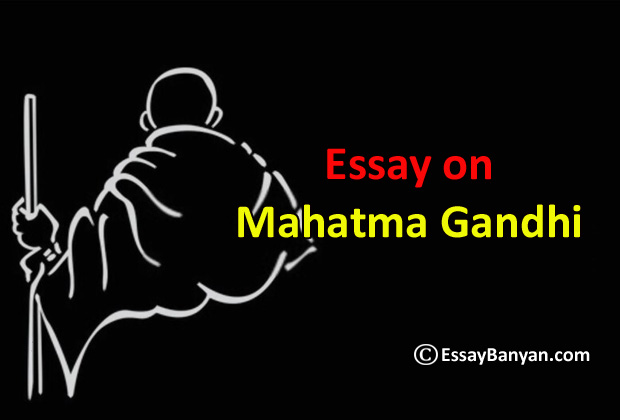
Freedom is the need of every living thing on this earth. However, this freedom does not come free of cost. We feel proud to say that our country India is an independent country but when we say this, we also remember the story behind this freedom. This freedom cost us millions lives and thousands of struggles. Many people fought tirelessly to make India an independent country. Moreover, when we talk about India’s independence movement, the first name that strikes our mind is “Mahatma Gandhi”. Every child of India is well aware of this name. So, to discover more about this famous personality, let us discuss Mahatma Gandhi in detail.
Mahatma Gandhi Essay in English
Here, we are presenting long and short essays on Mahatma Gandhi in English for students under word limits of 100 – 150 Words, 200 – 250 words, and 500 – 600 words. This topic is useful for students of classes 1, 2, 3, 4, 5, 6, 7, 8, 9, 10, 11, and 12 in English. These provided essays will also be helpful for students to write essay, speech, or paragraphs on this topic.
10 Lines Essay on Mahatma Gandhi (100 – 120 Words)
1) Mahatma Gandhi, born on October 2, 1869, was an Indian political leader.
2) His mother was Putlibai and father was Karamchand Gandhi.
3) He played a vital role in India’s struggle for independence against British rule.
4) He led several peaceful protests and movements, including the famous Salt March.
5) His beliefs and teachings inspired many other civil rights leaders around the world.
6) He was imprisoned numerous times for his protests against violence and injustice.
7) Gandhi was against the British rule and he worked hard to get India’s freedom.
8) Gandhi is widely known for his philosophy of nonviolence and civil disobedience.
9) He was shot on 30 January 1948 at 5:17 pm by Nathuram Godse.
10) Gandhi inspires people worldwide to fight for peace, justice, and equality.
Essay on Mahatma Gandhi (250 – 300 Words)
Introduction
Mahatma Gandhi is one of the most important people in India’s movement for independence. Mahatma Gandhi, Gandhi ji, father of the nation, bapu, etc are the various names of our beloved freedom fighter Mohandas Karamchand Gandhi.
Mahatma Gandhi: The Father of the Nation
Mahatma Gandhi was born in Porbandar, Gujarat on 2 nd October 1869 to Karamchand Gandhi and Putlibai. Mahatma Gandhi was an Indian writer, politician, lawyer, and social worker. Gandhi is often called the “Father of the Nation” in India, because his tireless efforts and selfless fight for freedom made him an advocate of the oppressed people. He supported civil resistance that didn’t involve violence and promoted the idea of Satyagraha, which means “the force of truth.”
Role of Gandhi in Independence Movement
Gandhi’s contribution to the Indian independence movement cannot be overstated. He believed that India could only achieve true freedom through non-violence and civil disobedience. In 1919, Gandhi called for a nationwide strike in protest against the Rowlatt Act. This led to widespread protests and marked the beginning of Gandhi’s mass civil disobedience campaigns. Gandhi organized several significant movements such as the Salt March in 1930. These movements got the attention and support of most Indians and were a key part of getting the country independence.
Gandhi’s ability to lead and his unwavering dedication to his cause have made him a true freedom fighter. His strategy of using nonviolence and civil disobedience to win freedom is still a great example of how peaceful resistance can change politics. As we remember and honor the “Father of the Nation,” let’s try to live by his values of truth, nonviolence, and social justice to make the world a better place for everyone.
Long Essay on Mahatma Gandhi (500 Words)
Mohandas Karamchand Gandhi, who was also known as Mahatma Gandhi, was an important leader in India’s fight for freedom. Gandhi was not only a political leader but also a great thinker and philosopher. His nonviolent approach to fighting injustice inspired individuals and movements around the world and continues to be remembered as a symbol of peace and resistance.
Mahatma Gandhi: Early Life
Gandhi was born on October 2, 1869, in Porbandar, Gujarat to Karamchand Gandhi and Putlibai. In May 1883, Mohandas, who was 13 at the time, got married to Kasturba devi, who was 14. He received his formal education in India and later studied law in London. Gandhi faced discrimination during his time in South Africa, which became a turning point in his life. This experience prompted him to fight for justice and equality, not only for Indians but for all oppressed people. When he got back to India, he became a well-known leader of the Indian National Congress.
Principles or Ideology of Gandhi Ji
Gandhi’s thought was based on the ideas of nonviolence, truth, and not caring about yourself. He thought that Satyagraha, a movement of nonviolent protest, could bring about social and political change. Gandhi was sure that violence leads to more violence and that kindness and understanding are the only ways to solve problems without violence. His ideas highlighted the value of being kind, forgiving, and loving to one’s enemies.
Contributions of Mahatma Gandhi
Gandhi’s contributions to the Indian independence movement were immense. He played a pivotal role in organizing mass protests, strikes, and boycotts against British rule. The Salt March, which he led in 1930, is widely regarded as one of his most significant accomplishments. This act of civil disobedience sparked international attention and brought the Indian independence movement to the forefront. Other than this, Gandhi ji also led Champaran and Kheda Agitations, Non-cooperation Movement, Quit India Movement, etc. He was also an advocate for women’s rights. He believed in gender equality and fought against social norms that oppressed women.
Legacy of Mahatma Gandhi
Gandhi’s idea of nonviolent resistance inspired leaders like Martin Luther King Jr. and Nelson Mandela to fight for human rights and equality. Truth and sincerity are still seen as important values for people who want to live in a fair and peaceful society. However, we lost this gem on 30 January 1948. Nathuram Godse, an extremist Hindu, shot and killed Mahatma Gandhi. The news of his death was felt all throughout the world. In India, 2 nd October is seen as Gandhi Jayanti and is a national holiday.
Mahatma Gandhi’s effect on the world cannot be overestimated. His peaceful way of fighting for freedom not only led to India’s independence but also changed the course of history for oppressed people all over the world. Gandhi’s ideas and teachings continue to inspire people and groups that work for peace, justice, and equality. Mahatma Gandhi will always be remembered as a sign of hope and courage in the face of hardship.
I hope the above provided essay on Mahatma Gandhi will be helpful in understanding his contribution for this country.
FAQs: Frequently Asked Questions on Mahatma Gandhi
Ans. Nathuram Godse killed Mahatma Gandhi, a spiritual leader known as the “Great Soul of India,” when he was 78 years old. “Hey Ram” were the last words Mahatma Gandhi spoke before he died from the gunshot.
Ans. On January 30, 1948, after a prayer gathering in New Delhi, Mahatma Gandhi was killed, he was 78 years old. At point-blank range, three bullets were shot into his chest and stomach.
Ans. Satyagraha was the most important tool Mahatma Gandhi used to fight the British and free India. The concept of Satyagraha was created by Mahatma Gandhi. It is a form of civil protest that doesn’t use violence.
Ans. “Mahatma,” which means “great soul,” was a name that people used to call Gandhi. Rabindranath Tagore, a poet and philosopher from Bengal, gave him this title.
Ans. Mahatma Gandhi hasn’t won either the Bharat Ratna or the Nobel Prize, but he was named 5 times for the Nobel Peace Prize between 1937 and 1948. The Court said that Gandhi Ji and the things he did will live on forever. Any award, including the Bharat Ratna, will hurt his reputation.
Related Posts
Essay on digital india, cashless india essay, essay on child is father of the man, essay on causes, effects and prevention of corona virus, essay on dr. sarvepalli radhakrishnan, durga puja essay, essay on summer vacation, essay on my plans for summer vacation, essay on holiday.
Essay on Moral Values and Principles of Mahatma Gandhi for Students

The following content is ideal for all class students, parents and teachers who are searching for Essay on Moral Values of Mahatma Gandhi
10 LINES on Moral Values and Principles of Mahatma Gandhi lines for Classes
- Mahatma Gandhi was a great leader who taught us the importance of moral values and principles in our lives.
- He believed in the principle of non-violence and encouraged people to solve their problems peacefully.
- Gandhi taught us to treat every human being with respect and dignity, irrespective of caste, religion, or social status.
- He believed in the power of truth and honesty.
- He always encouraged people to speak the truth.
- Gandhi also emphasised the importance of simplicity in life.
- He encouraged people to work hard and be self-reliant.
- Gandhi believed in the concept of self-discipline and taught us to control our thoughts and actions.
- He told the importance of education and believed that it was the key to personal and social development.
- Gandhi taught us to be kind and compassionate towards all living beings, including animals.
- Lines about Mahatma Gandhi (5 ,10 ,15 lines)
- Paragraph on Mahatma Gandhi in English
- Essay on Mahatma Gandhi in English
- Essay on Fundamental Duties of India
- Essay on Bal Gangadhar Tilak in English

Essay on Moral Values and Principles of Mahatma Gandhi for Classes 3 and 4 – 100 Words
Mahatma Gandhi was a great leader and his moral values and principles still inspire people across the world. Some of his key principles were non-violence, truthfulness, simplicity, self-discipline, and respect for diversity. He believed that violence only increases violence and that conflicts could be resolved through peaceful means. Gandhi highlighted the importance of truthfulness in all aspects of life. Self-discipline was another important principle for Mahatma Gandhi. He believed that one should have control over one’s own thoughts and actions. Simplicity was another core value that he lived by throughout his life. He believed in leading a simple lifestyle and avoiding materialistic pursuits.
Essay on Moral Values and Principles of Mahatma Gandhi for Classes 5 and 6 – 150 Words
Mahatma Gandhi was not only a political leader but also a symbol of moral values. He believed in truth, non-violence, compassion, and humility. Gandhi believed in the power of truth and always spoke his mind fearlessly. He believed that non-violence is the greatest force for good and it can bring about lasting change in society. He lived a simple life with respect for all forms of life. One of the most important moral principles he addressed was self-discipline or ‘self-rule’. True freedom comes from within when one has complete control over one’s own thoughts and actions. He highlighted the importance of equality among all individuals. He didn’t believe in caste, creed or religion. He fought against untouchability and discrimination against women throughout his life. Mahatma Gandhi’s morals were deeply rooted in spirituality. True spirituality is considered as an essential part of human existence. His teachings are still relevant today as we struggle to live together harmoniously in diverse societies around the world.

Essay on Moral Values and Principles of Mahatma Gandhi – 250 Words
Mahatma Gandhi is known as one of the most influential figures in Indian history and a leader. He advocated for non-violent civil disobedience to attain independence for India. His philosophy of non-violence, honesty, truthfulness, and compassion has inspired millions around the world. Gandhi placed immense importance on ahimsa or non-violence as a means to resolve conflicts peacefully without any loss of life or property. Mahatma Gandhi believed that morality was not something that could be imposed upon individuals through laws or rules but should be cultivated through self-discipline and introspection. For him, moral values were rooted in spirituality and inner peace which he called “Satyagraha”. Satyagraha means holding onto Truth even when it seems impossible. In today’s fast-paced world where people are driven by greed and selfishness, Mahatma Gandhi’s message of morality is more relevant than ever before. We need leaders who realise these values in their personal lives as well as in their public roles if we are to build a society based on justice and equity. The teachings of Mahatma Gandhi serve as an eternal reminder of what it truly means to lead a meaningful life filled with purpose, integrity, and compassion. In conclusion, Mahatma Gandhi remains an icon of moral excellence whose teachings continue to inspire generations across the globe. He saw morality as an integral component necessary for building strong societies founded on justice, equality to support freedom, independence, secularism and socialism etc.
Essay on Moral Values and Principles of Mahatma Gandhi for Classes 5 and 6 – 300 Words
Mahatma Gandhi was a man who lived his life based on strong moral values and principles. He believed that every individual should live their life with honesty, integrity, and compassion towards others. For him, the path of truth and non-violence were essential components of living an ethical life. Gandhi’s belief in non-violence has been one of his most important contributions to humanity. He believed that violence only causes more violence. Through Peaceful ways, we can resolve conflicts. His philosophy inspired many leaders around the world during the civil rights movement, including Martin Luther King Jr. Another important moral value for Gandhi was that he lived a life so simple. He led a simple lifestyle himself, wearing traditional Indian clothing and leading a frugal life without any luxuries or material possessions. One of the most important moral values is that Gandhi was truthful. He believed in speaking the truth no matter what the consequences may be. For him, honesty was one of the important pillars on which society should be built. Mahatma Gandhi also placed huge importance on compassion and empathy towards others’ suffering. According to him, every human being should work to reduce others’ pain as much as possible. His humility made him relatable to people from all walks of life. Furthermore, Gandhi also emphasised the importance of self-discipline as he believed this would lead to personal growth and success both spiritually and professionally. By practising self-control over our thoughts, words, and actions we are better able to achieve our goals while staying true to our core values. In conclusion, Mahatma Gandhi’s teachings continue to inspire generations even after his death because they promote values like love for fellow beings irrespective of social status or caste discrimination-free society equality between men & women etc., which remain relevant even today amidst changing times!

Essay on Moral Values and Principles of Mahatma Gandhi for Senior Students- 400 + Words
Introduction
Mahatma Gandhi, one of the most reviled figures in Indian history, was not just a political leader but also a personification of moral values and principles. He was Known for his non-violent approach to activism. He inspired millions around the world with his ideals of truthfulness, compassion, and integrity.
Who was Mahatma Gandhi?
Mahatma Gandhi was an Indian independence activist, who is widely recognized as one of the greatest and most influential leaders in modern history. Born on 2nd October 1869 in Porbandar, a coastal town in present-day Gujarat, he grew up to become a politically important figure and social reformer. Gandhi’s early years were marked by his love for truth and justice, which shaped his worldview on morality and ethics. He studied law in London and later worked as a lawyer in South Africa where he developed his philosophy of nonviolent resistance or Satyagraha. Upon returning to India, Gandhi became actively involved in the Indian freedom struggle against British colonial rule. He led several successful campaigns such as the Salt March that resulted in India gaining its independence from Britain. Throughout his life, Mahatma Gandhi remained committed to promoting peace and tolerance among people of different faiths and cultures. His teachings on non-violence have inspired countless individuals around the world including civil rights leader Martin Luther King Jr., and anti-apartheid revolutionary Nelson Mandela among others.
What were Gandhi’s views on morality and ethics?
Morality- Mahatma Gandhi was a man of high moral character, and his views on morality and ethics were deeply rooted in his spiritual beliefs. For him, morality was not just a set of rules or principles to be followed; it was a way of life that reflected one’s innermost values. Self-Realisation- According to Gandhi, the ultimate goal of human life is to attain self-realisation or enlightenment. This can only be achieved by living a moral and ethical life, based on truthfulness, non-violence, compassion, and service to others. Introspection and Meditation- Gandhi believed that true morality comes from within oneself rather than being imposed from external sources such as religion or society. He saw each individual as having a natural sense of right and wrong which could be cultivated through introspection and meditation. Truthfulness- For Gandhi, truthfulness was the foundation of all moral behaviour. He believed that one should always speak the truth regardless of the consequences. Non-violence too played an important role in his philosophy as he saw it as another evidence of truthfulness. Mahatma Gandhi’s views on morality were founded upon deep spiritual beliefs centred around truthfulness and nonviolence.
How did Gandhi’s beliefs shape his actions?
Gandhi’s beliefs had an intense impact on his actions and the course of India’s fight for independence. One of Gandhi’s core principles was nonviolence, which he believed could bring about change without resorting to aggression or hatred. This belief in non-violence led him to undertake various forms of peaceful resistance, such as civil disobedience and hunger strikes. He believed that these methods would not only help achieve political goals but also promote spiritual growth among individuals. Another important principle for Gandhi was self-reliance, which he called “swaraj.” He encouraged Indians to become more self-sufficient by promoting local industries and rejecting foreign goods. This idea aimed at reducing India’s dependence on British rule. Furthermore, Gandhi emphasised the importance of equality and social justice. He fought against caste discrimination and worked towards empowering women through education. His views on these issues were ahead of his time, inspiring future generations. It is evident that Gandhi’s beliefs shaped every aspect of his life and work towards achieving a free India based on moral values rather than violence or oppression.
What lessons can we learn from Gandhi about morality and ethics?
Mahatma Gandhi’s life and teachings offer a number of lessons about morality and ethics. These are the lessons which we can apply in our daily lives. One of the most important lessons is the power of non-violence. Gandhi showed us that violence only leads to more violence. Another lesson we can learn from Gandhi is the importance of self-discipline. He believed that a person must have control over their thoughts, words, and actions to win the world. Gandhi also believed in treating everyone with respect, regardless of their background or social status. He advocated for equality among all people and fought against discrimination based on caste or religion. Gandhi emphasised the value of simplicity and living a sensible lifestyle. He also encouraged others to live simple lives. There are many valuable lessons we can learn from Mahatma Gandhi about morality and ethics such as non-violence, self-discipline, respect for others, and simplicity.
Mahatma Gandhi was not just a political leader but also a moral and ethical philosopher who inspired millions with his principles and values. He believed in the power of non-violence, truthfulness, compassion, humility and simplicity. These values helped him to lead India to independence from British rule. Gandhi’s teachings on morality and ethics are still relevant today. They remind us that we must strive for goodness, kindness and justice in all our actions. We can learn from his life how to live an honest, simple and fulfilling life without compromising on our principles.
1. Is Mahatma Gandhi’s values and principles diminishing and portrayed in a negative way? Answer – Not at all! Mahatma Gandhi’s values and principles are still alive, respected, and appreciated by many people around the world. His message of peace and non-violence is still relevant today. As long as we continue to remember his moral values and principles, they will not diminish or lose their importance in any way. Though there are a few people who are over-smart and want to show that they know more than anyone. For such people, there is no good principle. Such people may criticize the values. 2.What was Mahatma Gandhi’s philosophy on moral values and code of conduct? Answer – Mahatma Gandhi was a strong advocate of non-violence, justice, and truth. He believed that people should live their lives with the highest moral values, such as courage, kindness, truthfulness, and empathy. He also believed in the power of forgiveness, selflessness, and service to others. He advocated for a life lived in harmony with nature and promoted satyagraha (insistence on truth) as a form of civil disobedience against oppression. His fundamental principles of morality include ahimsa (non-violence), swadeshi (self-sufficiency) and Sarvodaya (the welfare of all). 3.What are some of Mahatma Gandhi’s principles? Answer – Mahatma Gandhi’s principles were founded on truth, non-violence, and equality. He believed in the power of peaceful protest, ethical and moral responsibility, respect for all life, and self-sacrifice in service to others. He also preached truthfulness and humility as keys to a fulfilling life. In his practice of Satyagraha, he emphasised that civil disobedience is only justified when used as a last resort to fight injustice.
4.Who was Mahatma Gandhi and what were his principles? Answer – Mahatma Gandhi was a political and spiritual leader who played a significant role in India’s struggle for independence from British colonial rule. He was born on October 2, 1869, in Porbandar, India, and was assassinated on January 30, 1948, in New Delhi, India. Gandhi’s principles were rooted in his philosophy of nonviolence, which he called Satyagraha, his deep commitment to social justice and his belief in the equality of all people, regardless of their race, caste, or religion, believed in the importance of simplicity and self-sufficiency.
Related Posts

Gandhi as a Great Leader
Mahatma Gandhi is one of the greatest leaders of all time. He is the father of a nation and led the Indian civil rights movement that freed India from British rule. There are many characteristics that Gandhi had that made him an exceptional leader, but there are two that stick out: his ability to be to lead by example and his persistence.
Before Gandhi led the Indian civil rights movement, India was a country that had multiple diverse nationalities. It was very difficult to get the country unite under one leader. However, Gandhi was able to be a leader and gather followers from all over India. He was able to unite India under one leader by leading through his own example .

(Image Source: ThoughtCo. )
There were several occasions where Gandhi acted in a way that others admired and willingly followed. First, the way he dressed helped him fight for his cause. He wore a cotton cloth called a dhoti , a shawl and a simple watch and glasses. A dhoti is a traditional Gujarati outfit that is wrapped around one’s legs and waist, and a shawl is a scarf he wrapped around his upper body. Dhotis and shawls are usually worn by the poorest of people. He wore this to boycott foreign clothes and represent the millions of people living in India at the time. Many followed his example and began boycotting British clothing for more traditional wear. Gandhi did not only limit his traditional attire to his home and the streets but wore traditional clothes even in front of Congress . He stood in front of Congress in a dhoti and shawl to tell the nation that the Congress would no longer belong to the upper class. He stuck with his word to wear traditional clothes and did not change for anyone or anything. In this way, Gandhi was able to influence others by setting an example of how to stand up for what they believed in.
Not only was Gandhi a great role model, but was also very persistent and consistent in his beliefs. He was very determined in following through what he believed in. Even at the most basic level, Gandhi believed in keeping his promises. For example, Gandhi promised his mother before leaving that he would remain a vegetarian and he maintained his promise despite difficulty. On a grander scale, Gandhi very strongly believed in non-violence and showed how non-violence was an ultimate solution with the salt tax protest.
Gandhi is a famous leader of the non-violence movement. He followed the religious principle “ ahisma ” (doing no harm) that was common to Hinduism, Buddhism, and Jainism. Gandhi believed that non-violence was the true force and the whole idea of non-violence was to convert the thinking of the opponent. This approach was incorporated when he protested the salt tax .
During that time, the British had a monopoly over salt production and sales, so anyone but the government who was caught making or selling salt would be criminally charged. The salt tax was one of the biggest sources of revenue for the British government, so Gandhi believed that protesting it would be the first step towards India’s freedom.
Image Source: MSNBC
Gandhi and thousands of other followers made salt along the coastlines. Over 60,000 people were arrested in a few short months but none of them resisted arrest. Gandhi was eventually arrested as well however, he did not fight back with any violence but only used words to fight his battles. Even if the British officers used force or violence, Gandhi and his followers only acted peacefully. This protest grabbed the attention of Indians all throughout the nation, creating an impressive amount of followers. It also brought international recognition to Gandhi’s nonviolent approach.
Today’s leaders do not seem to demonstrate the same quality of leadership that Gandhi did. Instead of following what they believe in, they are often hypocritical. When it came to personal possessions, unlike today’s leaders, Gandhi had the barest minimum and was still was able to successfully fight for his country. Also, many leaders are not persistent in their beliefs and often do not follow through. If today’s leaders are able to encompass some of what Gandhi was able to, they would be able to gain more respect and have more loyal followers.
View all posts
You may also like

Trauma Dumping: A New Form of Manipulation

The Effects of Dehumanizing “The Other”

Opinion: The Many Identities of Disability
Lost your password?
- Science & Tech
- Social Issues
- Humans of INKspire
- Artificial Intelligence
- Arts Criticism
- Black History
- Discovering your Identity
- Growth and Transformation
- Healthy Living
- Human Brain
- Mental Health
- Philosophy and Spirituality
- Relationships
- Social Media
- Sustainability
- Urban Legends
- World Cuisine
- Meet the Writer Fellows
- Become a Writer
Latest Posts
The eras of taylor swift: her evolution as a musical artist, ai and the legal profession: navigating the new frontier, the powerful portrayal of intersectionality in sex education, popular tags, popular search.
- Digital Media

StarsInsider
Mahatma Gandhi: Remembering the life and work of the "Great Soul"
Posted: April 4, 2024 | Last updated: April 4, 2024
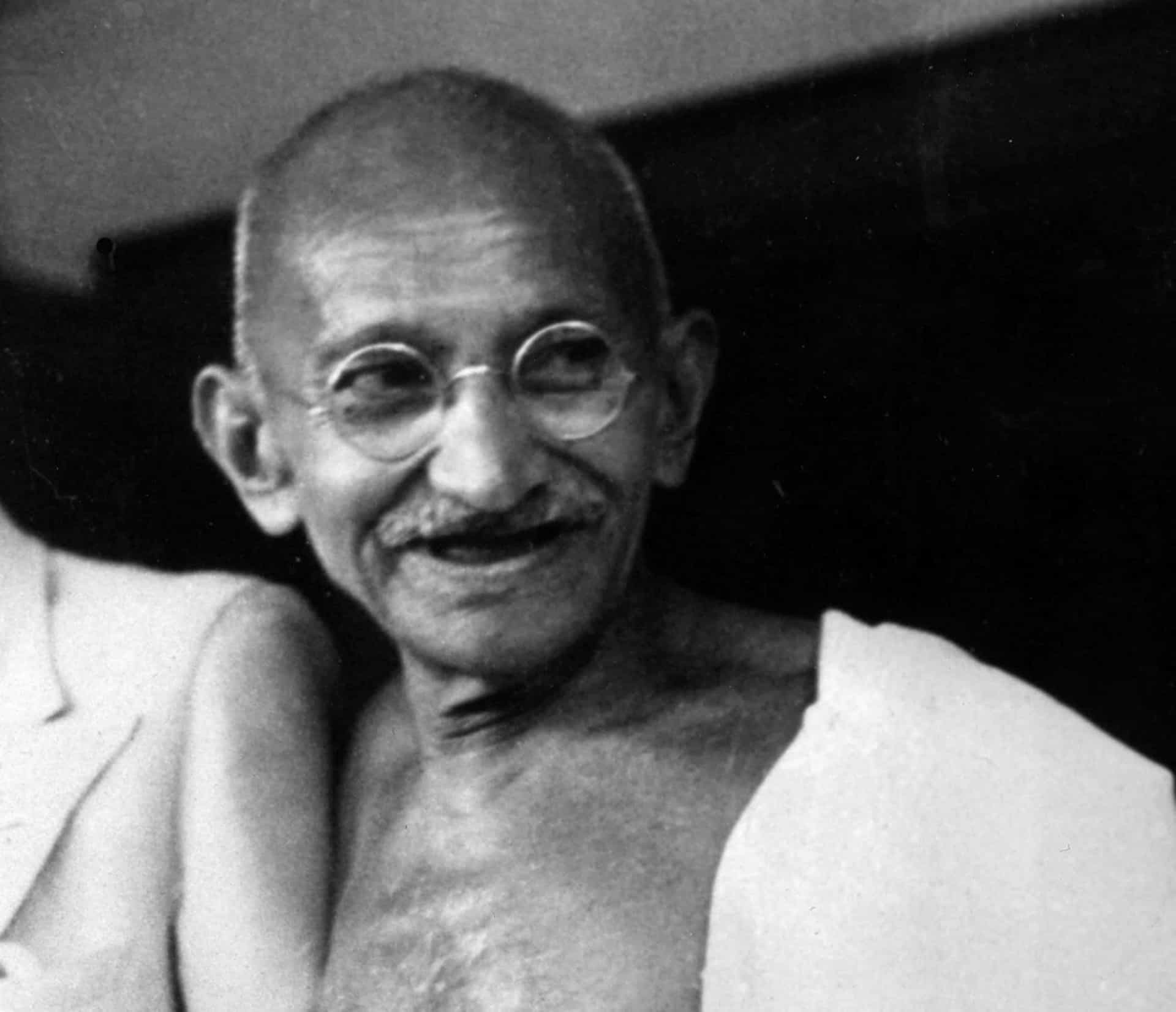
Born October 2, 1869, Mahatma Gandhi was an Indian lawyer, politician, social activist, and writer who became the leader of the nationalist movement against the British rule of India. Employing a policy of nonviolent resistance, he successfully campaigned for the country's independence. In turn, he inspired movements for civil rights and freedom across the world. He lived to see India granted the right to govern itself. He also witnessed the partition of the country, an event that led indirectly to his assassination on January 30, 1948.
Click through the gallery and relive the key moments that shaped the life and work of the man they called the Mahatma, or "Great Soul."
You may also like: Unprofessional stars involved in spats at work
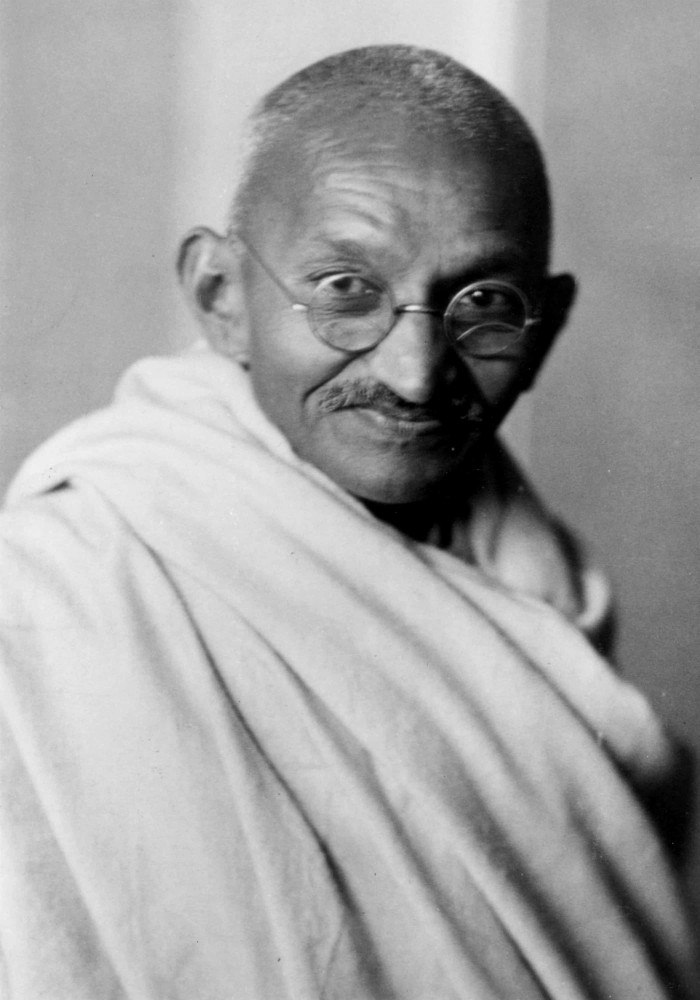
Mahatma Gandhi
Mohandas Karamchand Gandhi, more commonly known as "Mahatma" (meaning "Great Soul") was born in Porbandar, Gujarat, in northwest India, on October 2, 1869.
Follow us and access great exclusive content every day
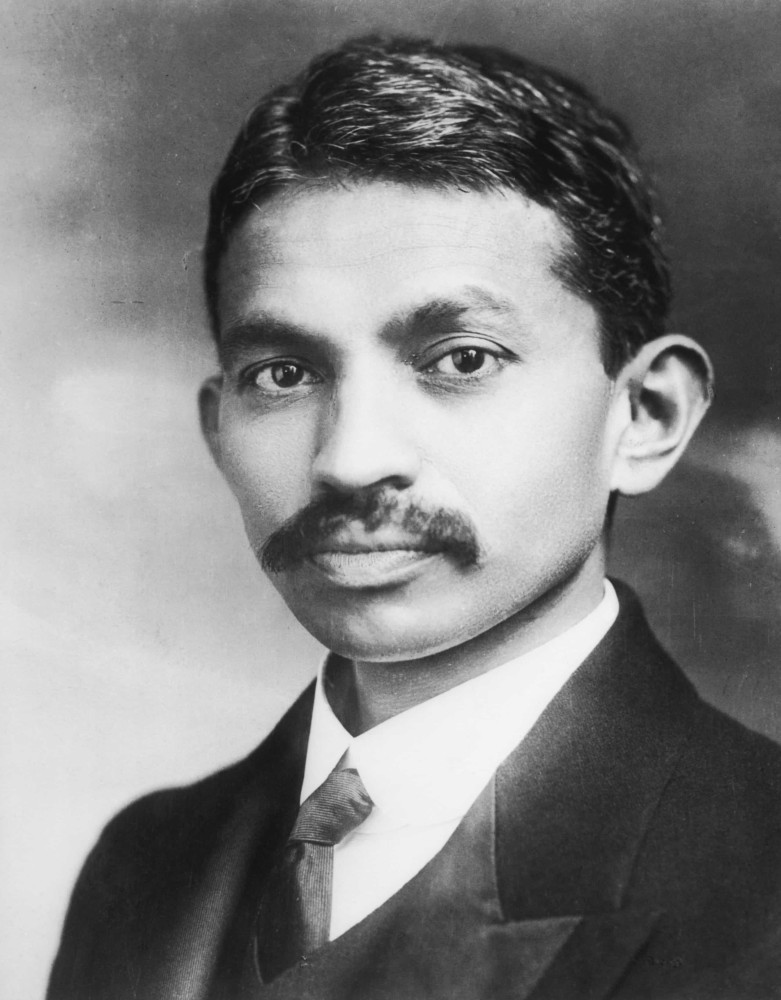
Career in law
Gandhi trained in law at the Inner Temple in London, and was called to the bar at age 22 in June 1891.
You may also like: Why Australia doesn't exist according to flat-Earthers
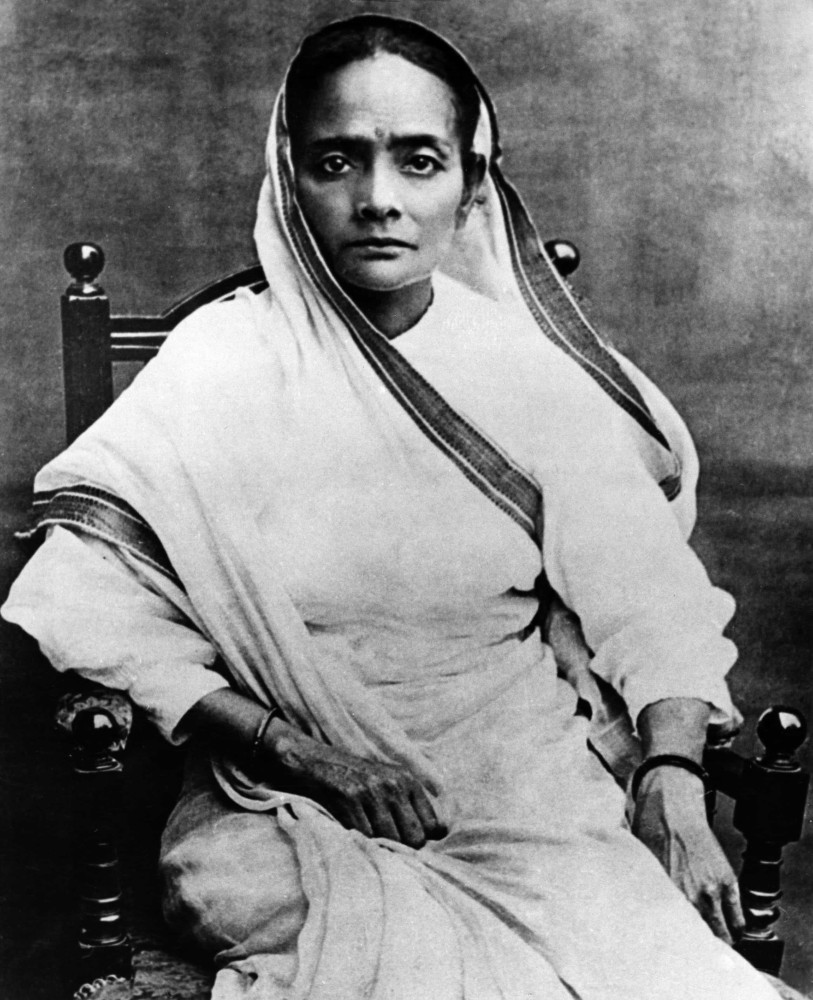
Kasturba Gandhi (1869–1944)
The young lawyer was already a husband, having married Kasturbai Makhanji Kapadia (her first name was usually shortened to "Kasturba") in 1883 when he was just 13 years old.
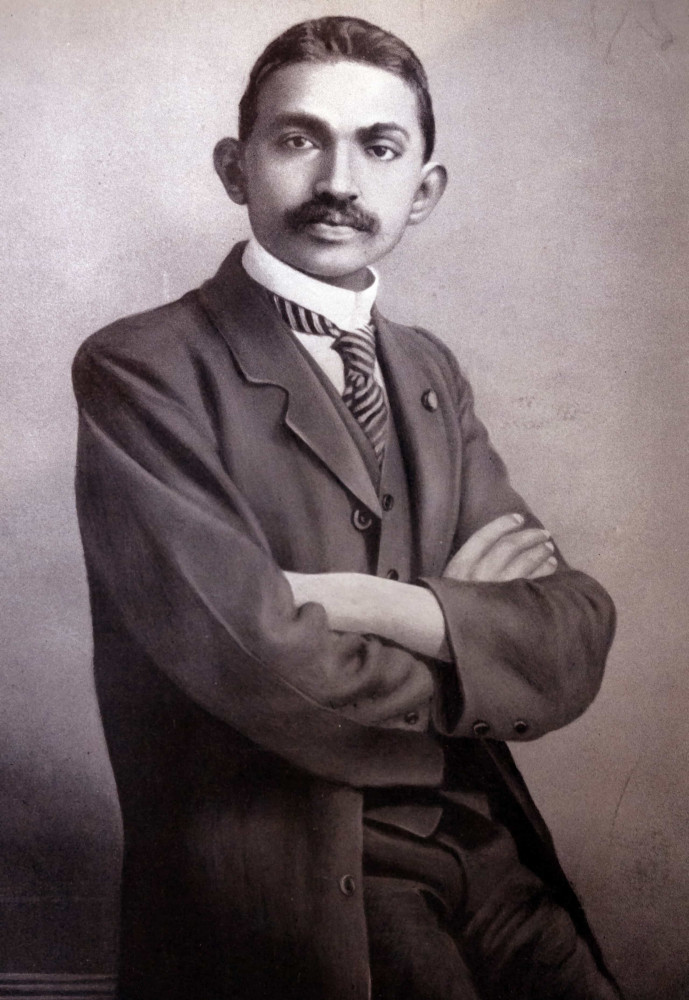
Return to India
Just a few weeks after being called to the bar in London, Gandhi returned to India after learning that his mother had died. He attempted to establish a law practice in Bombay (modern-day Mumbai) but ended up making a modest living drafting petitions for litigants in Rajkot.
You may also like: Stars whose loved ones suffered tragic deaths

South Africa
The need by a distant cousin for a qualified lawyer in Johannesburg led Gandhi to travel to South Africa in 1893, where he eventually opened his own law practice (pictured). He spent a total of 21 years in the country during which he developed his political views, ethics, and politics—and where he faced discrimination because of his skin color and heritage, like all people of color.
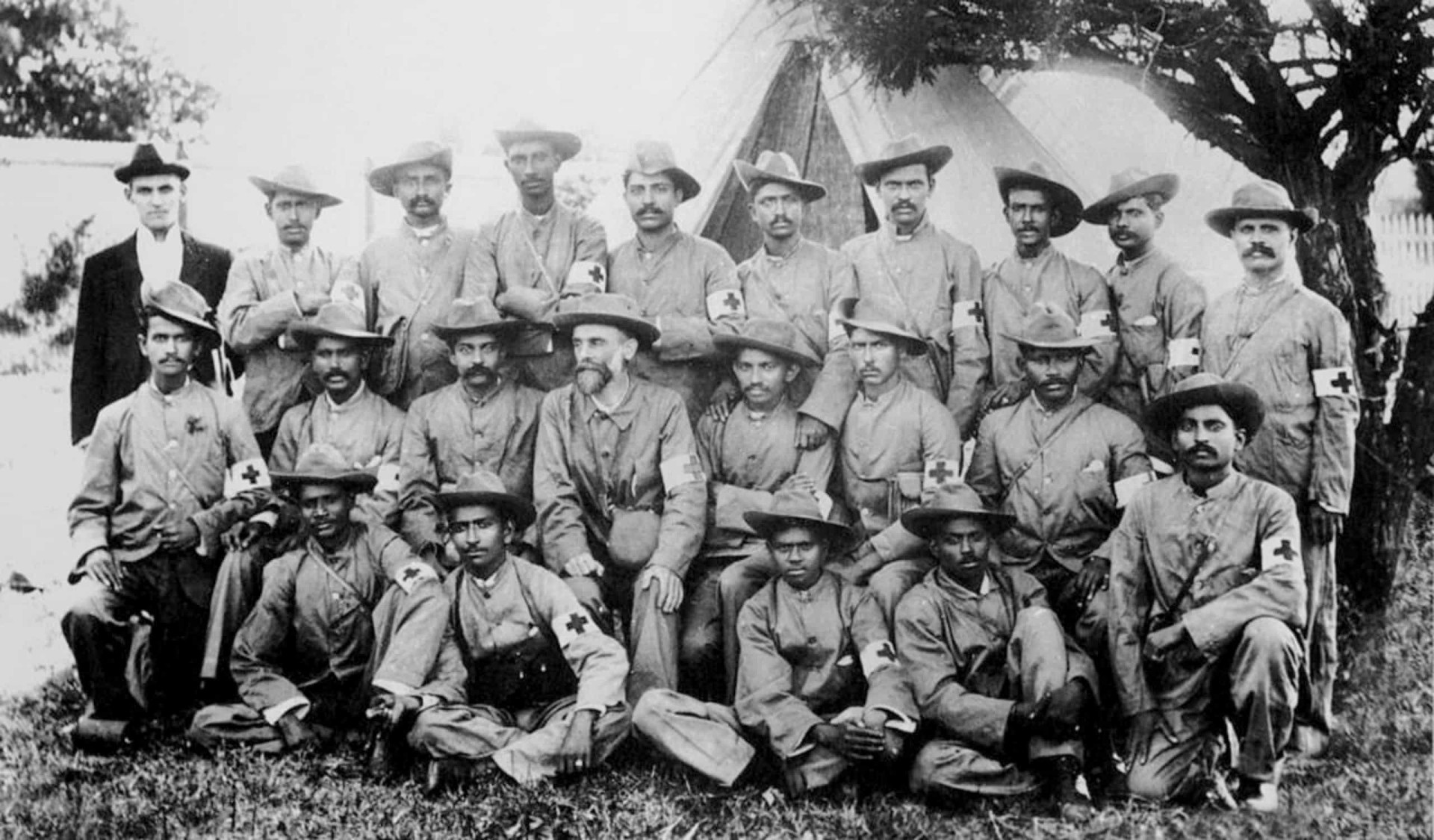
During the Boer War (1899–1902), Gandhi volunteered to form a group of stretcher-bearers as the Natal Indian Ambulance Corps. He eventually raised 1,100 Indian volunteers to support British combat troops against the Boers. He's pictured here with colleagues (middle row, fifth from left) in 1900.
You may also like: Endangered foods that may soon disappear from our planet
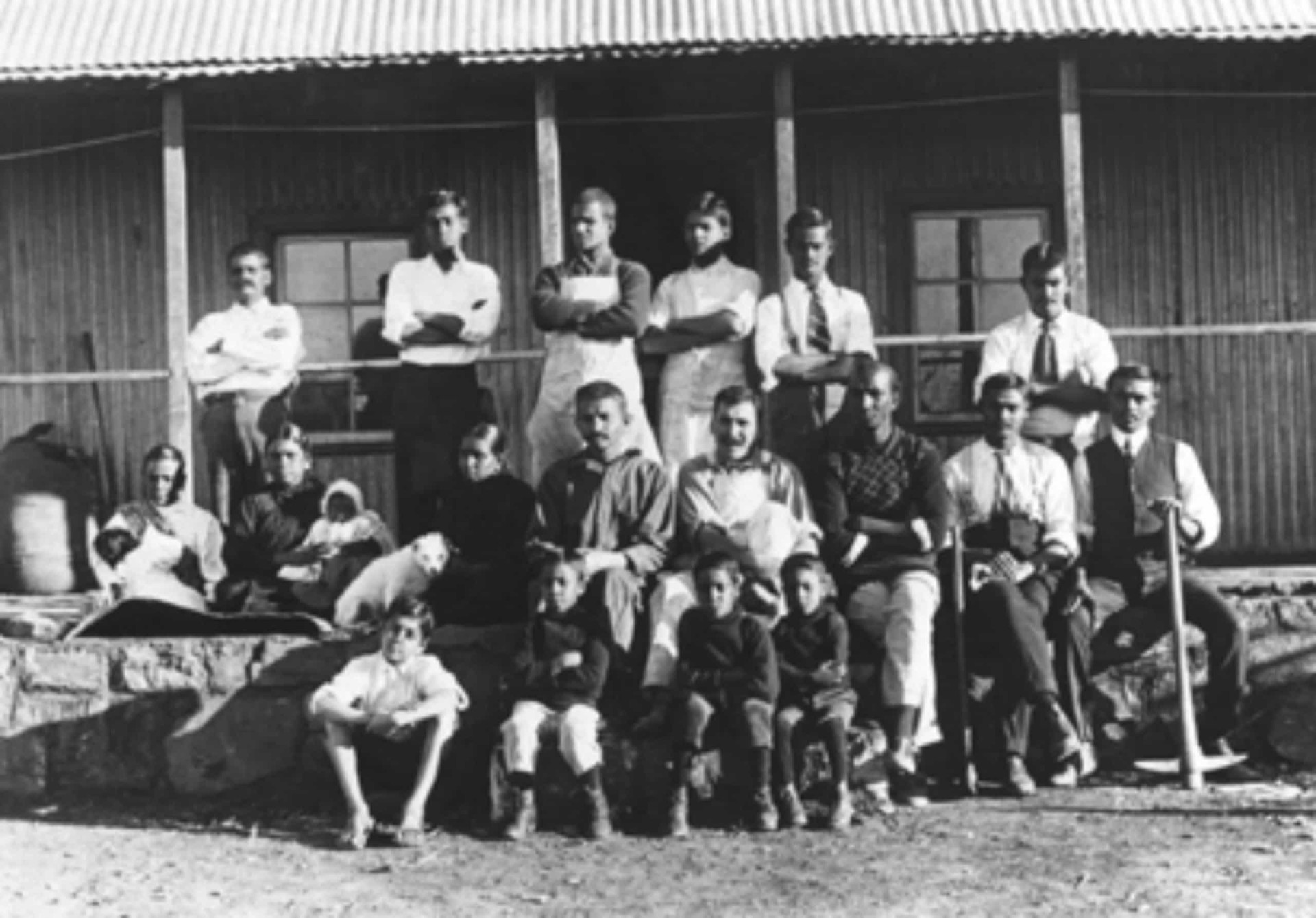
Tolstoy Farm
Further discrimination and bullying encouraged Gandhi to enter politics by forming the Natal Indian Congress and seeking voting rights for Indians. In 1910, Gandhi initiated and organized his first ashram, Tolstoy Farm (pictured), named after Russian writer and philosopher Leo Tolstoy, whose 1894 book, 'The Kingdom of God Is Within You,' greatly influenced Gandhi's science of nonviolence. Gandhi is seen in the middle, second row fifth from the right.
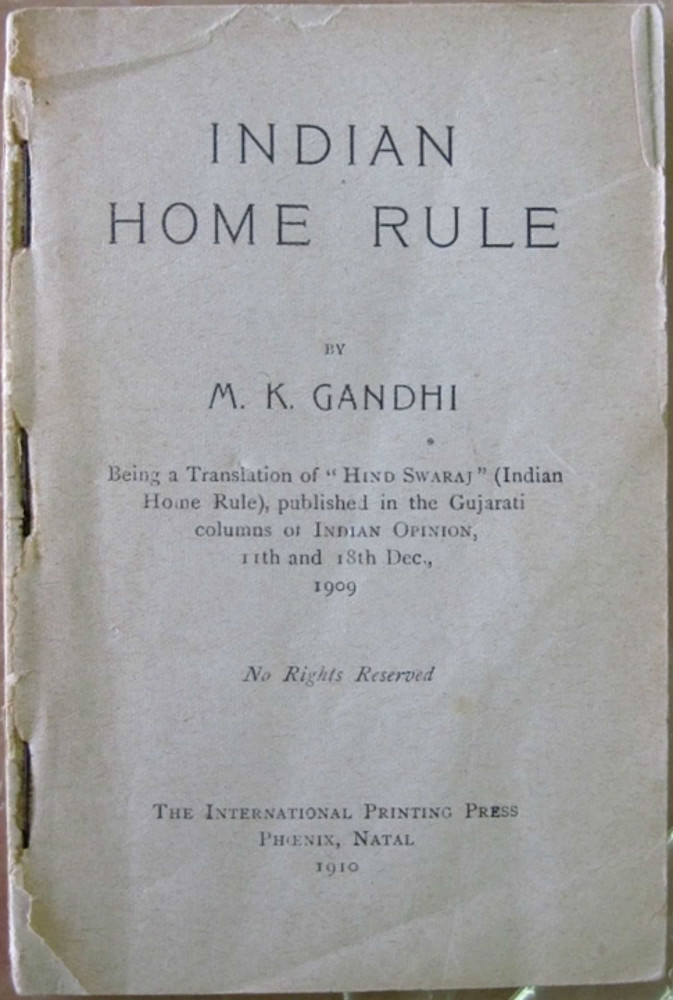
'Hind Swaraj' or 'Indian Home Rule'
In 1915 Gandhi returned to India and joined the Indian National Congress. By 1920 he was leading it. As a noted Indian nationalist, theorist, and community organizer, he galvanized the call for the independence of India. He'd said as much in his 1909 book 'Hind Swaraj,' which means "Indian Home Rule." The book was banned in 1910 by the British government in India as a seditious text.
You may also like: A history of political statements on the red carpet
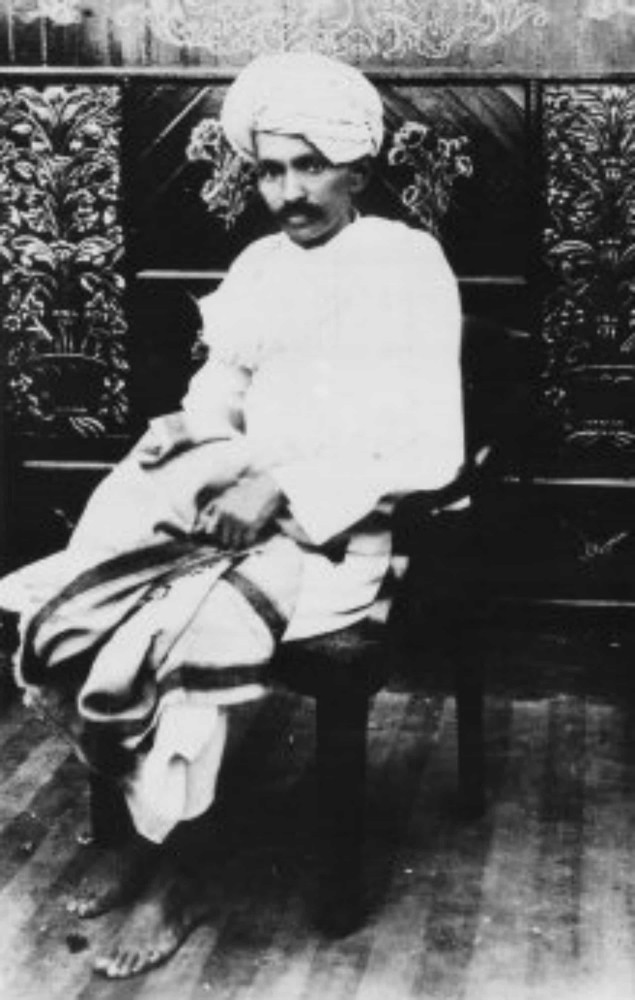
Champaran Satyagrahas
Gandhi's first major political achievement came in 1917 with the Champaran agitation in Bihar, which pitted local peasantry against their British landlords. Gandhi eventually won concessions from the authorities.
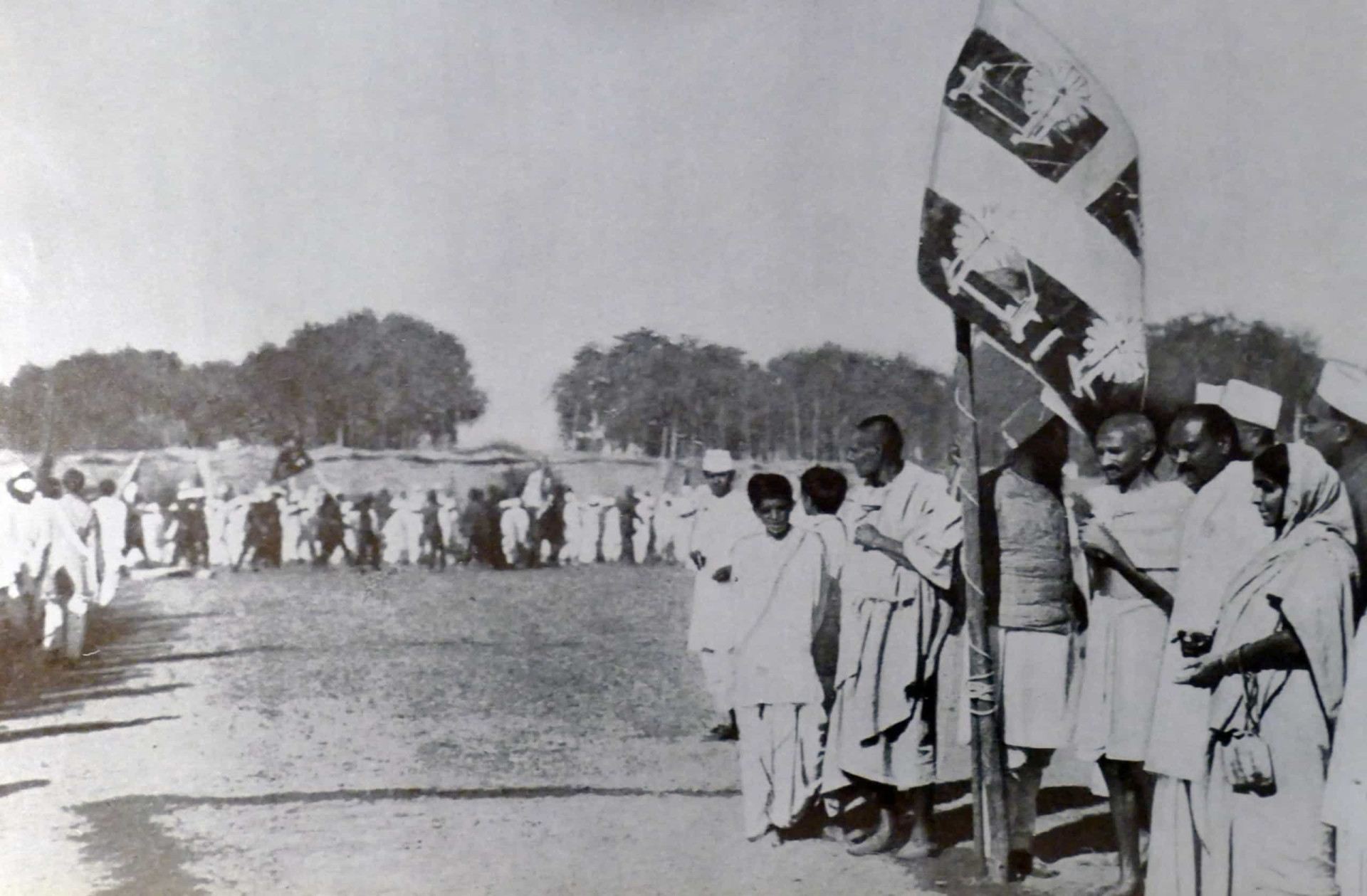
Khilafat movement
The Khilafat movement was an agitation by Indian Muslims, allied with Indian nationalists, to pressure the British government to preserve the authority of the Ottoman Sultan as Caliph of Islam after the First World War. Gandhi sought political co-operation from Muslims in his fight against British imperialism by supporting the Ottoman Empire. This helped stop the increasing Hindu-Muslim violence that was spreading across the nation. However, by the end of 1922 the Khilafat movement had collapsed and deadly religious riots reappeared in numerous cities.
You may also like: Stars who have come out as LGBT in 2019

Identifying with India's poor
Gandhi is photographed upon his release from prison in Poona, walking with some of his followers in 1918. Gandhi had by now adopted the loin-cloth as a symbol of his identification with India's poor. The following year, British authorities passed the Rowlatt Act, which gave powers to the police to arrest any person without any reason whatsoever. Gandhi responded by appealing to Indians to start civil disobedience.
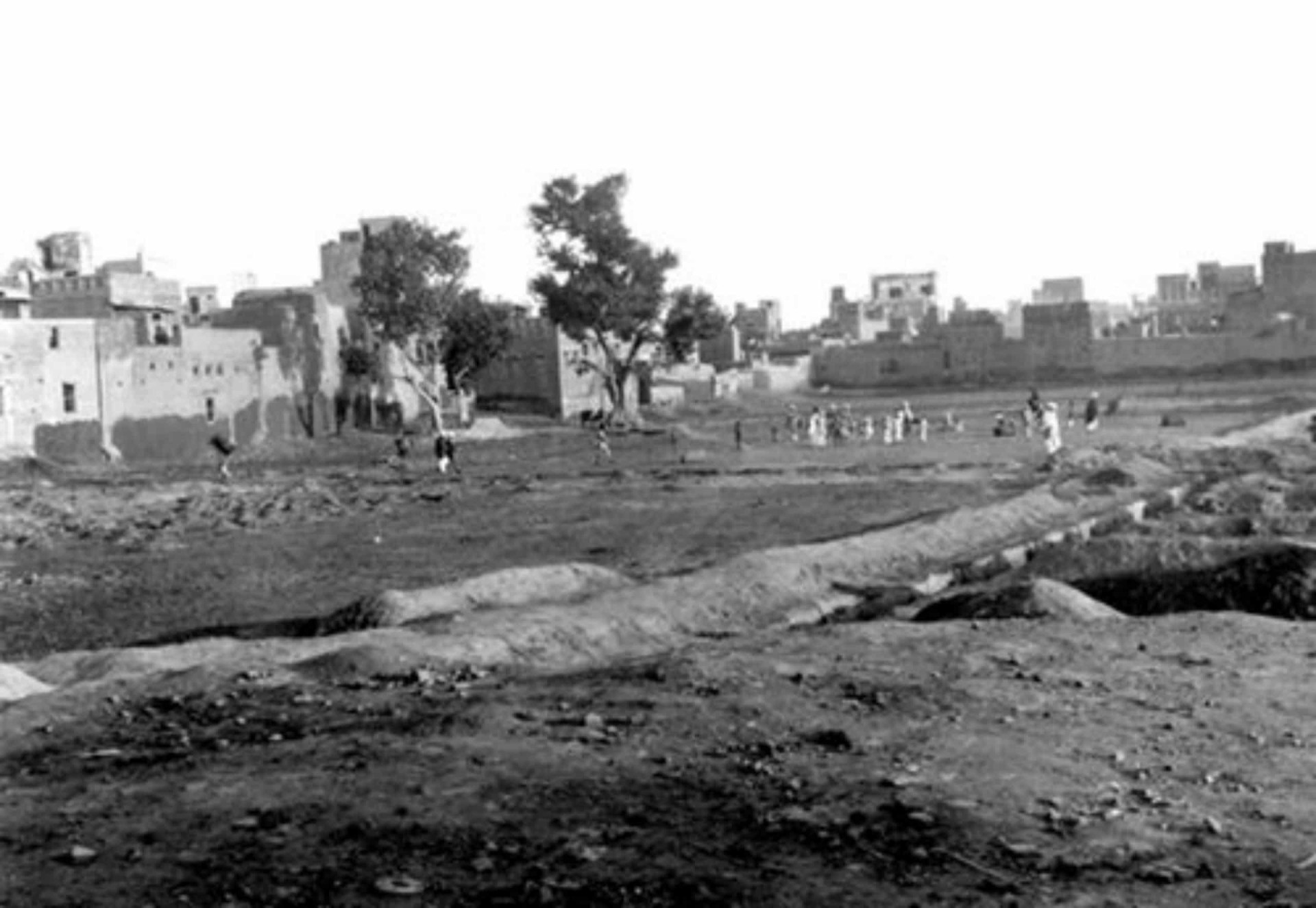
Jallianwala Bagh massacre
On April 13, 1919, people (including women with children) gathered at Jallianwala Bagh in Amritsar to celebrate the festival of Baisakhi and to protest the arrest and deportation of two nationalists. Troops of the British Indian Army opened fire on the crowd for 10 minutes, killing an estimated 1,000 people and injuring up to 1,500. Pictured is the park a few months after the massacre.
You may also like: Surprising uses and effects of apple cider vinegar
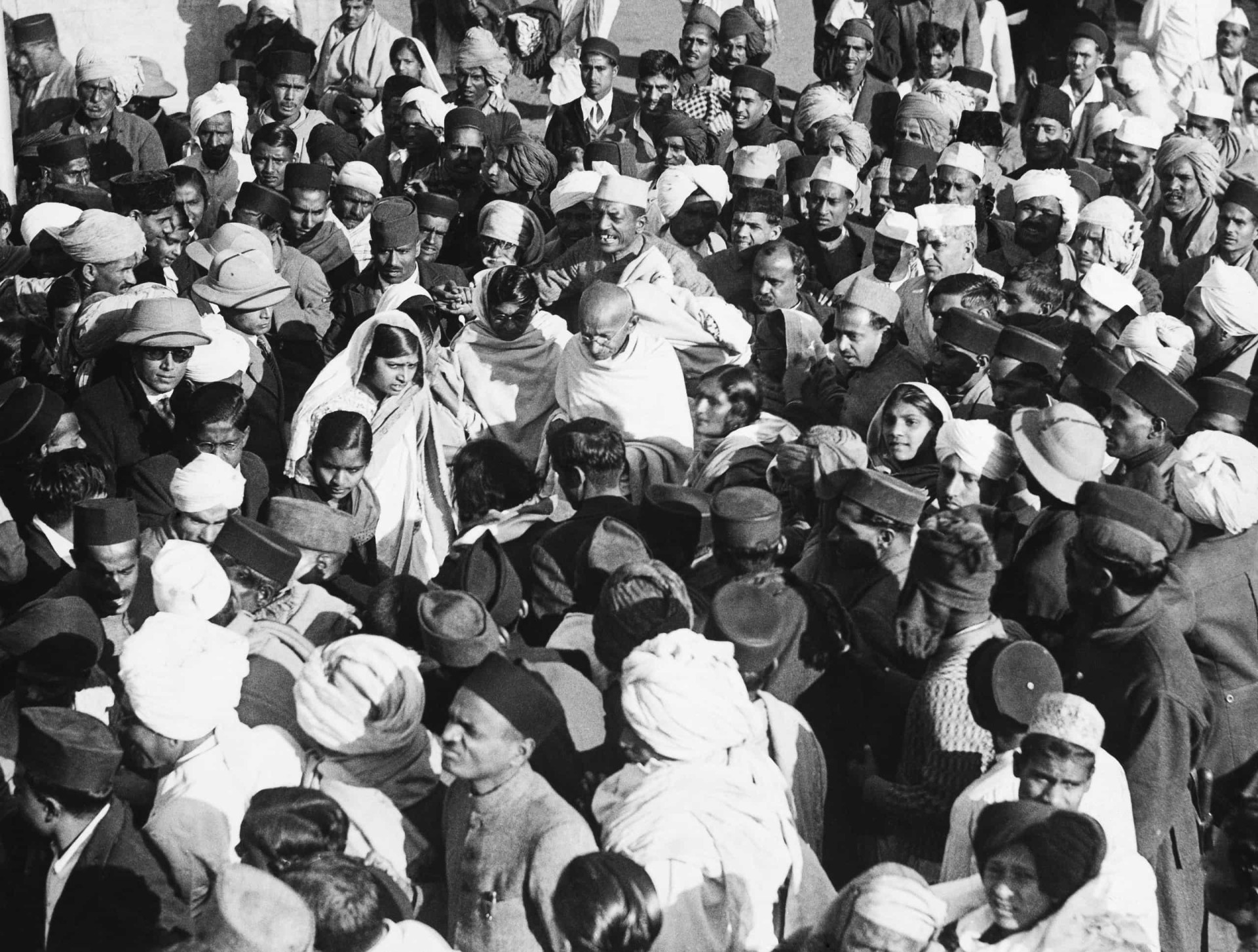
Non-cooperation movement
In the wake of the passing of the Rowlatt Act and the Jallianwala Bagh massacre, Gandhi launched the non-cooperation movement on September 5, 1920, with the aim of self-governance and independence.

Swadeshi movement
Gandhi also expanded his nonviolent non-co-operation platform to include the "swadeshi" policy—the boycott of foreign-made goods, especially those from Britain. He urged Indian men and women, rich or poor, to spend time each day spinning khadi (homespun cotton) in support of the independence movement. The image of Gandhi making kadhi, by using a spinning wheel called a chakra, came to symbolize the man and the movement.
You may also like: 30 of the best films directed by women
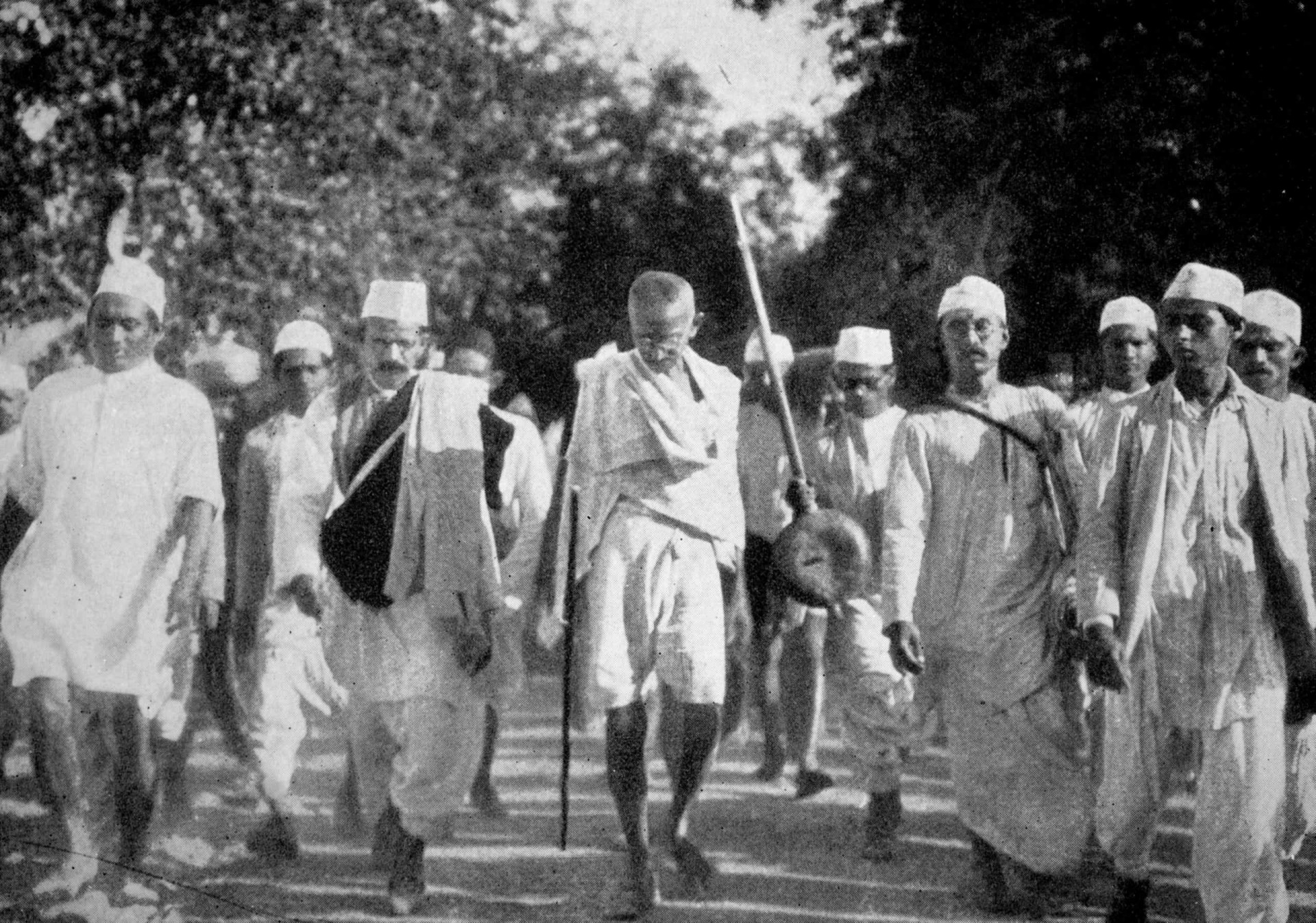
From March 12 to April 6, 1930, Gandhi, together with 78 volunteers, marched 388 km (241 miles) from Ahmedabad to Dandi, Gujarat, in protest at the tax of salt imposed by the British earlier that year. His intention was to start making salt himself.
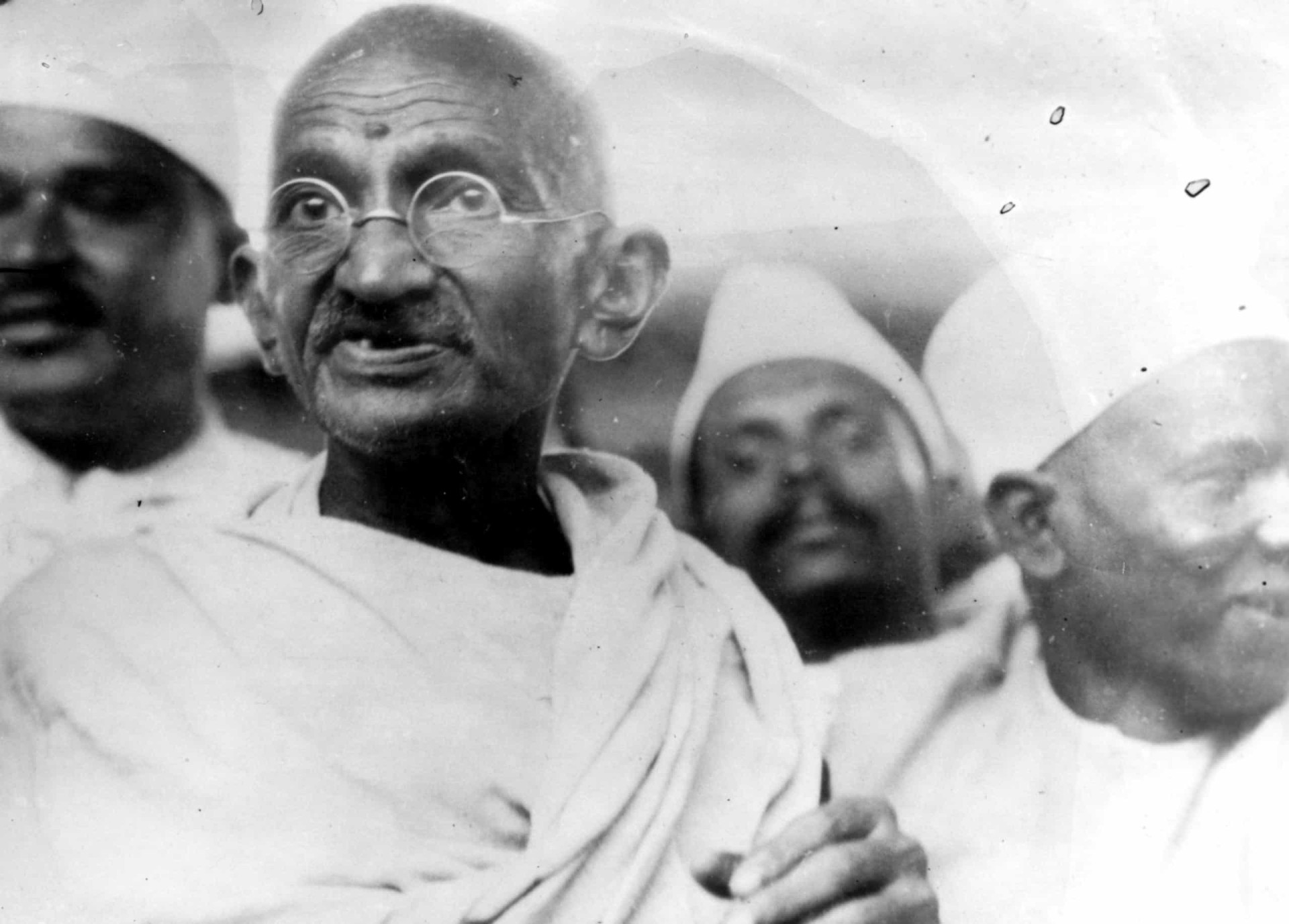
Gandhi spoke to often huge crowds along the way. After arriving in Dandi, he was interned. A wave of beatings by police soon followed, resulting in 300 or so protesters seriously injured. Peaceful resistance had again turned ugly, but at no time did the marchers offer any resistance.
You may also like: The most mind-bending movies ever made
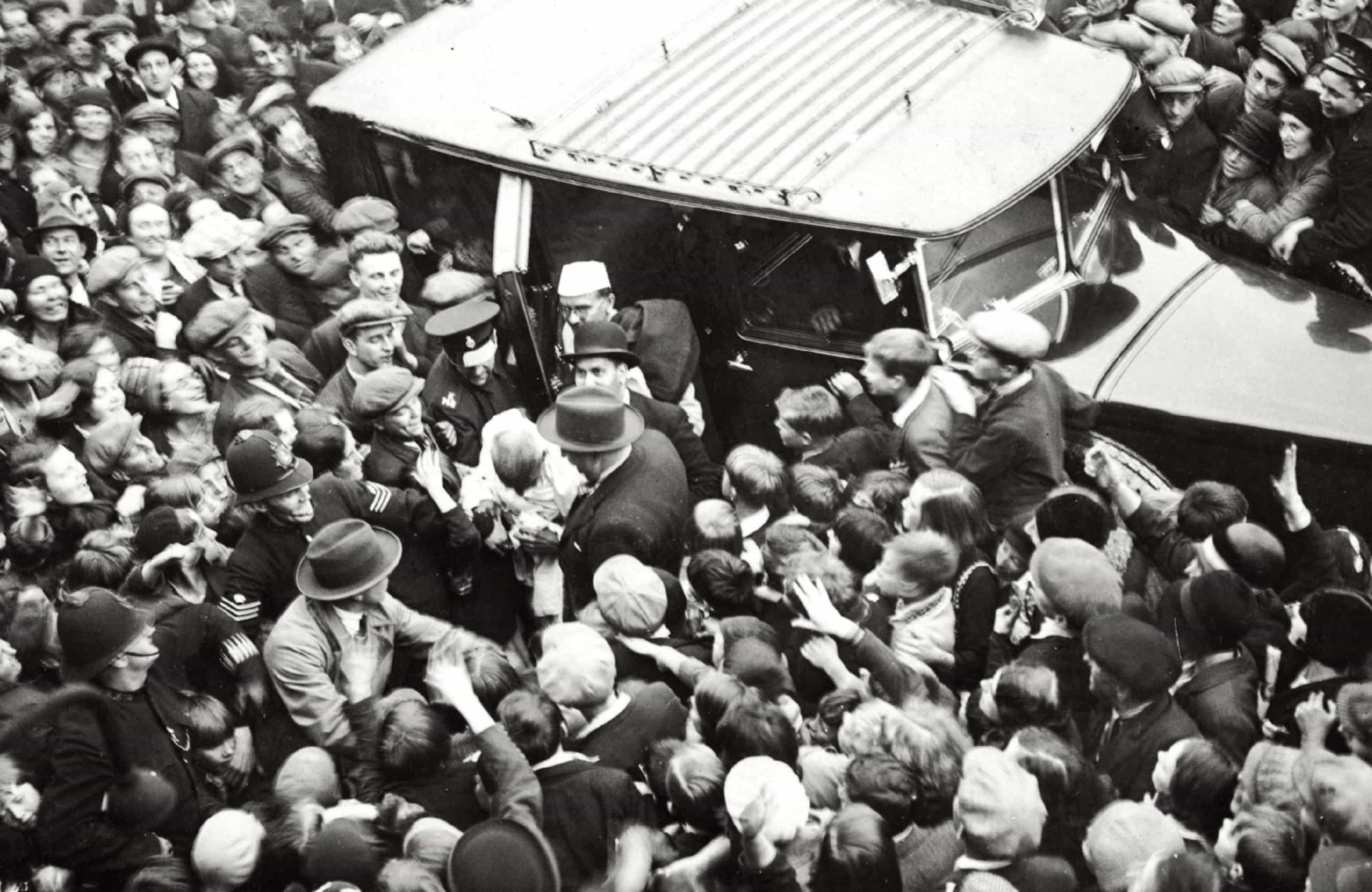
Arrival in England for the Round Table Conference
Gandhi visited England in 1931 to begin negotiations with the British government to end the political impasse strangling India. He's seen here arriving with personal secretary Mahadev Desai at Canning Town in London's East End.
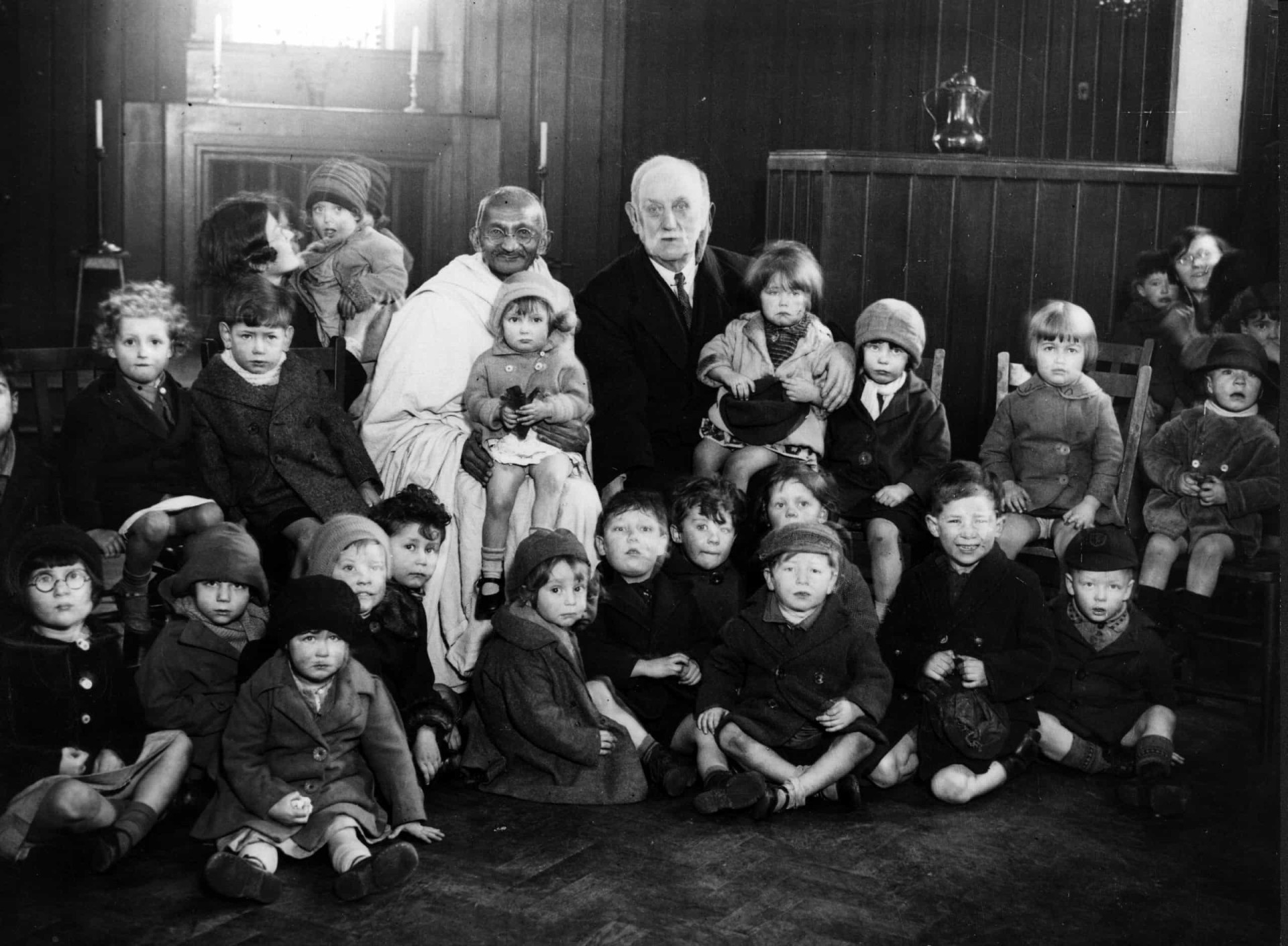
Home from home
Gandhi eschewed the comforts of a hotel stay offered by the government and instead stayed at Kingsley Hall with Labour Party member and social reformer George Lansbury. Both are pictured meeting local children.
You may also like: Movie sequels that cut out main characters
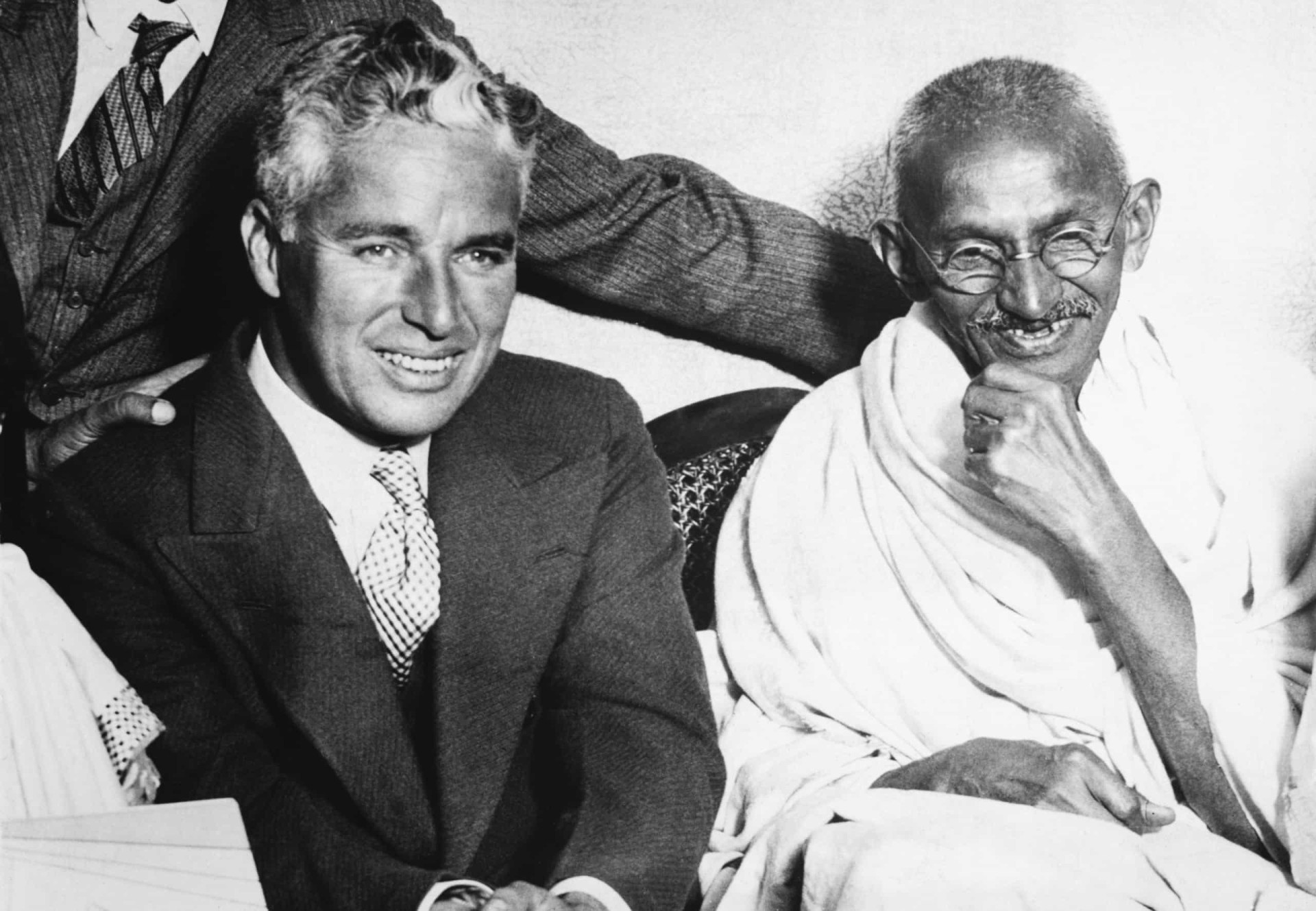
Meeting Charlie Chaplin
Gandhi took time out to meet Charlie Chaplin , though he professed to not having previously heard of the "Little Tramp." Associates assured him of the comedian's popularity and a meeting was arranged.

Gandhi–Irwin Pact
The conference ended with a settlement being reached between Gandhi and Viceroy Lord Irwin known as the Gandhi-Irwin Pact. The British Government agreed to free all political prisoners, in return for the suspension of the civil disobedience movement. For his part, Conservative politician Winston Churchill remained critical of Gandhi, accusing him of playing on the ignorance of the Indian masses and even describing him as a dictator.
You may also like: Celebs attacked by animals
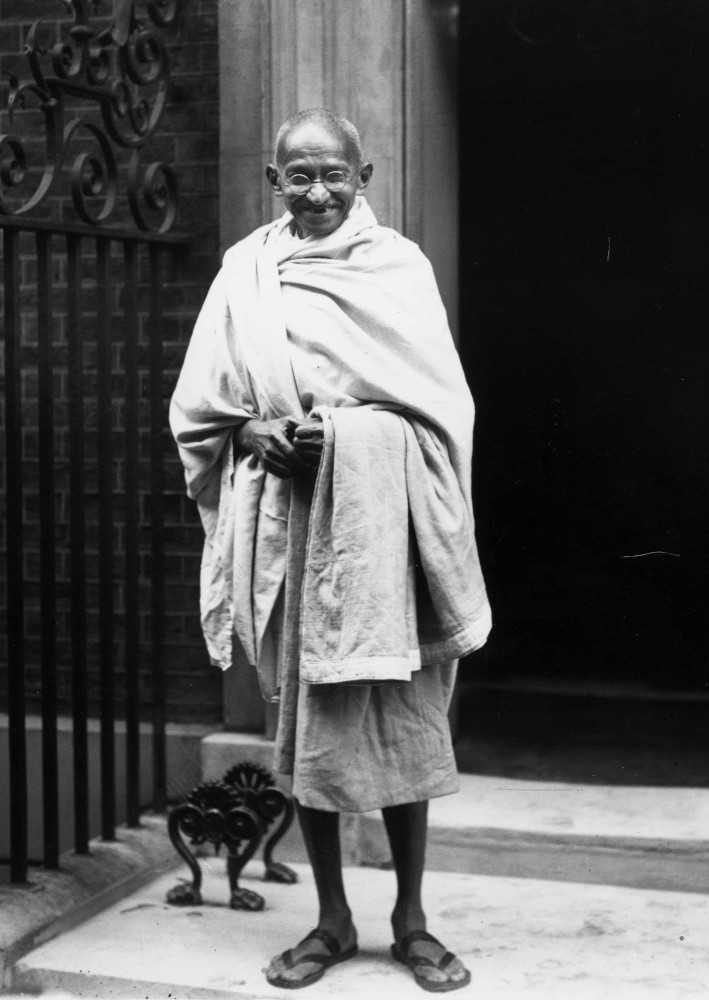
Stepping up to the challenge
In a now famous image, Gandhi is photographed on the steps of 10 Downing Street, the Prime Minister's residence, while attending the conference in London.

Arrest of Gandhi
Gandhi was arrested and detained on numerous occasions throughout his lifetime. Invariably, thousands would gather in protest. This procession took place in Bombay when the Indian National Congress working committee organized a demonstration protesting the detention yet again of their leader.
You may also like: The best worst films ever
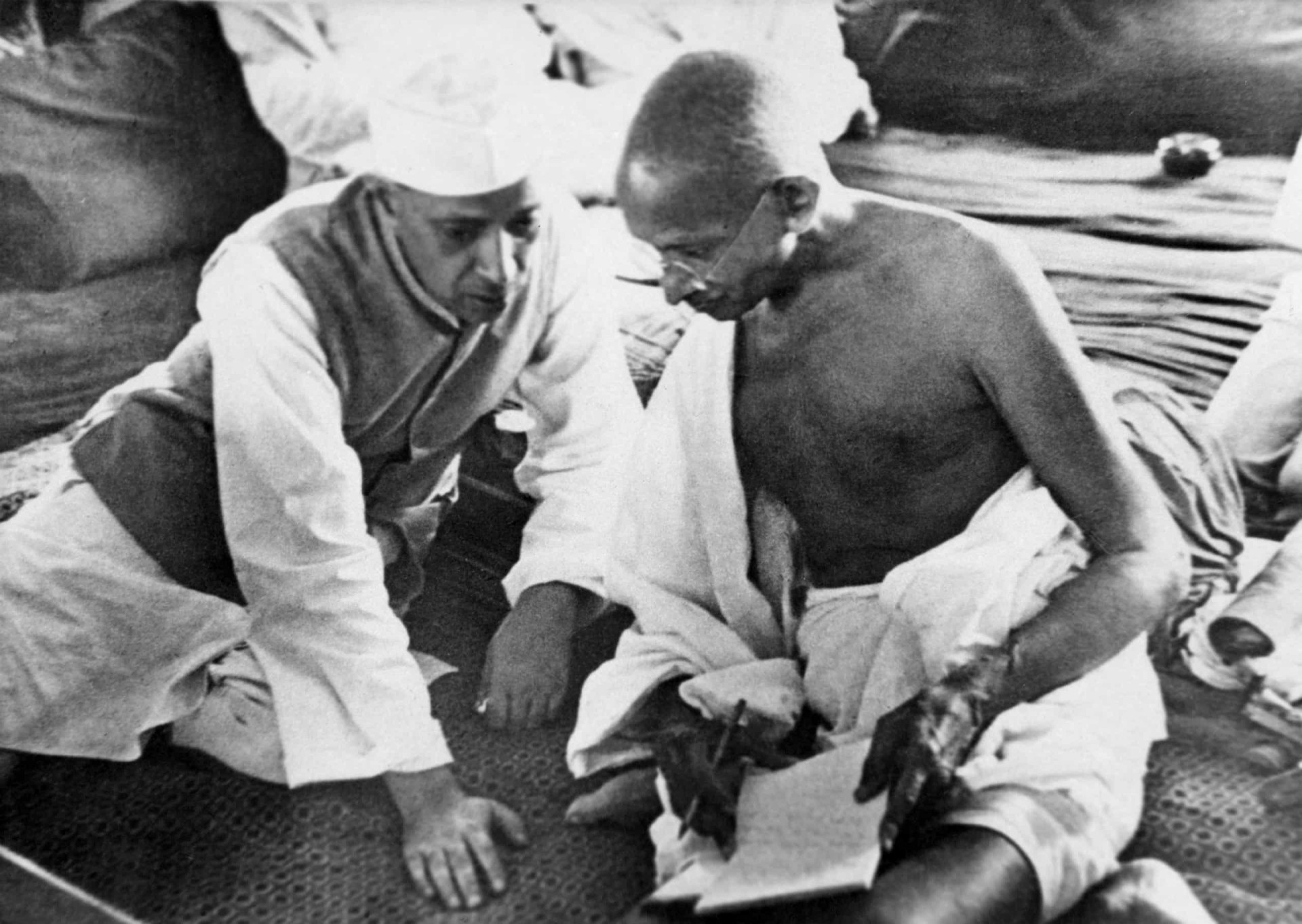
Quit India movement
Launched at the Bombay session of the All-India Congress Committee by Gandhi in August 1942, the Quit India Movement demanded an end to British rule in India. After Gandhi's speech calling for an "orderly British withdrawal," almost the entire Congress leadership were imprisoned, and remained behind bars for the duration of the Second World War. Gandhi is pictured with Jawaharlal Nehru (1889–1964).

Suppression of the movement
The Congress leadership was cut off from the rest of the world for over three years. Large protests took place across India; the British responded with mass detentions. Gandhi himself went on a 21-day fast and maintained his resolve to continuous resistance. Meanwhile his wife, Kasturba, had died, and Gandhi's health was declining.
You may also like: Scandals that the Catholic Church doesn't want you to know about

Indian independence movement
Gandhi had always opposed the partition of the Indian subcontinent along religious lines. However, the Muslim League led by Muhammad Ali Jinnah (the future founder of Pakistan), demanded "Divide and Quit India." The Direct Action Day of August 16, 1946, called for by Jinnah led to a mass cycle of violence against Hindus and retaliatory action against Muslims. The threat of civil war across the Indian subcontinent was palpable. Pictured is Gandhi with Muhammad Ali Jinnah.
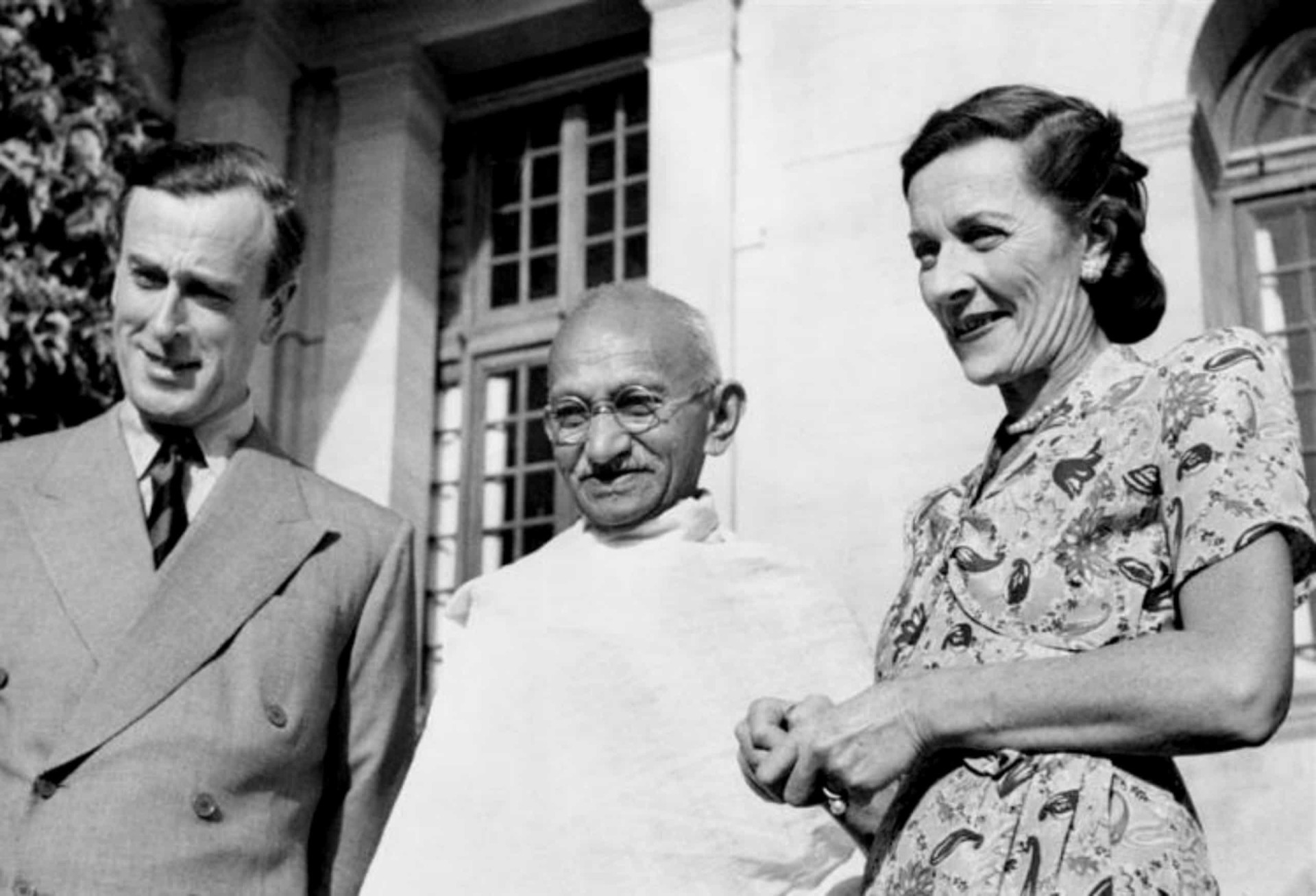
Independence is won!
Archibald Wavell, the Viceroy and Governor-General of British India, worked with Gandhi and Jinnah to find a common ground. Eventually the British reluctantly agreed to grant independence to the people of the Indian subcontinent, but also accepted Jinnah's proposal of partitioning the land into Pakistan and India. After Wavell retired, Lord Louis Mountbatten became Britain's last Viceroy of India and the first governor-general of independent India (1947–1948). He's pictured here with his wife, Edwina, and Gandhi in 1947.
You may also like: Unsolved mysteries of the universe that have puzzled scientists for centuries
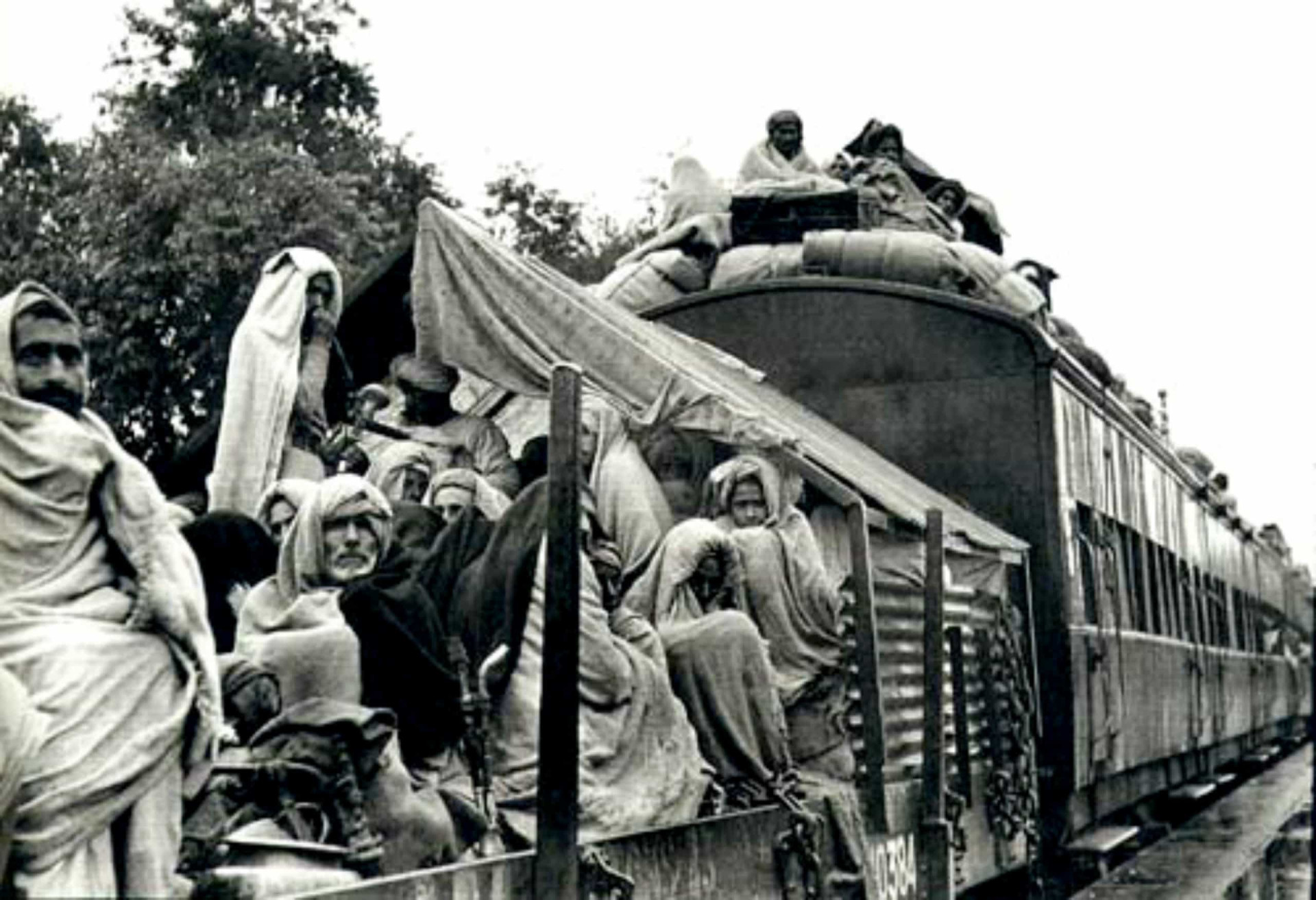
Partition of India
The Partition of India of 1947 was the division of British India into two independent dominion states, India and Pakistan. The partition displaced between 10–12 million people along religious lines, and created an overwhelming refugee crisis. Large-scale violence ensued, with several hundred thousand people losing their lives. Pictured is a crowded refugee train on its way to Punjab, Pakistan. Many Hindi nationalists held Gandhi responsible for the frenzy of violence and sufferings during the subcontinent's partition, and pointed towards his perceived compliance towards Muslims.
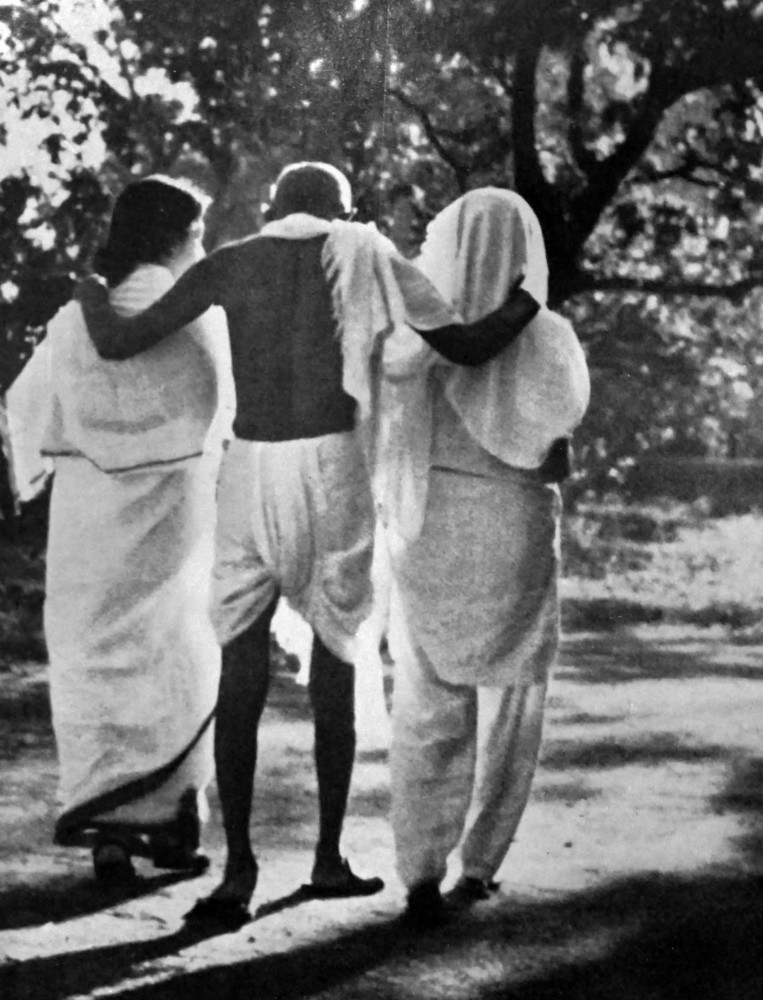
Assassination
On January 30, 1948, Gandhi was with his grandnieces in the garden of Birla House (now Gandhi Smriti) on his way to address a prayer meeting. He was approached by Nathuram Godse, a Hindu nationalist, who shot the 78-year-old three times from close range, killing him almost instantly. Godse, along with several other conspirators, was executed the following year.
You may also like: The dark history of sin-eaters

Gandhi's funeral in New Delhi was marked by millions, and his death mourned worldwide. He was cremated in accordance with Hindu tradition. Jawaharlal Nehru became his political heir, and the first Prime Minister of India.

Gandhi Smriti
Gandhi Smriti in New Delhi, formerly known as Birla House, is a museum dedicated to Gandhi, and where he spent the last 144 days of his life. Within the grounds is a memorial, the "Martyr's Column," which marks the spot where he was killed. It's one of the city's most popular visitor attractions.
Seed also: History's most influential and inspiring women
More for You
Missing '1923' actor Cole Brings Plenty, 27, found dead in Kansas
Donald Trump Bond Rejected Due to Low Fee, Insurer Suggests
Here's What Happens When You Keep a Car For Over a Decade
7 CDs You Probably Owned, Threw Out and Now Are Worth Bank
US air force finds two causes in death of contractor who walked into propeller
The least popular dog breeds in America, based on American Kennel Club data
Southwest Airlines makes a major onboard safety change
Joaquin Phoenix And 150 Hollywood Creatives Sign Open Letter Supporting Jonathan Glazer
Gavin Newsom's Restaurant Offers $16 Hourly Wage To Employee
#MeToo's Tarana Burke on Diddy Allegations: "The Zeitgeist Has Changed and People Are Ready to Believe the Survivors"
9 Insider Secrets You Should Know From a Goodwill Employee
24 Old Vinyl Records That Can Be Worth a Lot Today
People Who Had Unhappy Childhoods Usually Develop These 18 Traits
Chaos at Heathrow as two aircraft collide on the tarmac
Cicada Map Shows States Where Trillions Of Bugs Will Emerge
Should you tip on restaurant takeout? Or a coffee order? We're being asked for tips more often — here's when it's OK to decline.
What to do when your own number appears to ring your home phone
I’m a Mechanic: 4 Signs You’re Buying a Lemon
‘Death cleaning’ isn’t morbid, it’s the healthiest thing you can do
5 Issues With Their Parents That Gen Z Brings Up Most In Therapy

IMAGES
VIDEO
COMMENTS
500+ Words Essay on Mahatma Gandhi. Essay on Mahatma Gandhi - Mahatma Gandhi was a great patriotic Indian, if not the greatest. He was a man of an unbelievably great personality. He certainly does not need anyone like me praising him. Furthermore, his efforts for Indian independence are unparalleled. Most noteworthy, there would have been a ...
Mahatma Gandhi Essay in English 150 Words. Mahatma Gandhi was a great leader. His full name was Mohandas and Gandhi. He was born on October 2, 1869 at Porbandar. His father was a Diwan. He was an average student. He went to England and returned as a barrister. In South Africa, Gandhiji saw the bad condition of the Indians.
Get original essay. Thesis statement: There is a very famous Indian leader who was not born as great but he made himself great through his hard works and struggles, and his name is Mohan Das Karamchand Gandhi and in India he is famously known as "Bapu" or "Rastrapita". Background: He was born on October 2, 1869 in Porbandar, Gujarat, India.
Dinodia Photos/Getty Images. Revered the world over for his nonviolent philosophy of passive resistance, Mohandas Karamchand Gandhi was known to his many followers as Mahatma, or "the great ...
Mahatma Gandhi (born October 2, 1869, Porbandar, India—died January 30, 1948, Delhi) Indian lawyer, politician, social activist, and writer who became the leader of the nationalist movement against the British rule of India. As such, he came to be considered the father of his country.
Leaders transform the lives of the surrounding communities and pass their experiences to future generations. One of the world's greatest leaders was Mahatma Gandhi, leading many protests to liberate India. The leader's background was diverse, but most of the time, he spent on law and political movements to make his home country independent ...
A second element of Gandhi's leadership was his lifelong commitment to achieving that intertwined vision of a successful Indian nation. Starting in the 1890's with his work in South Africa ...
Executive summary. Mahatma Gandhi is perhaps the greatest leader of the millennium. His leadership pioneered peaceful and non-violent civil disobedience and set the stage for the development of human rights. Ghandi used transformative, people-centred, charismatic and servant leadership to lobby for India's independence from the British.
Mohandas Karamchand Gandhi, often called the 'Father of the Nation', was a leader who fought for India's freedom from British rule.He believed in non-violence. Every year on October 2nd, Mahatma Gandhi's birthday is celebrated as Gandhi Jayanti to honor his efforts in freeing India.. English Essay on Mahatma Gandhi. Rabindranath Tagore was the first to call Gandhiji 'Mahatma,' which means ...
Mahatma Gandhi - Nonviolence, Indian Independence, Satyagraha: For the next three years, Gandhi seemed to hover uncertainly on the periphery of Indian politics, declining to join any political agitation, supporting the British war effort, and even recruiting soldiers for the British Indian Army. At the same time, he did not flinch from criticizing the British officials for any acts of high ...
Introduction. Mahatma Gandhi, a name that resonates with peace and non-violence, is my favourite leader. His life and teachings have inspired millions worldwide. Born as Mohandas Karamchand Gandhi on October 2, 1869, he later came to be known as 'Mahatma', meaning 'great soul'. His principles of truth and non-violence have become a ...
In conclusion, Mahatma Gandhi's leadership style, characterized by nonviolent resistance, the ability to inspire and mobilize masses, and an emphasis on moral integrity, holds enduring significance and relevance. ... How Gandhi Used Perseverance to Achieve Change Essay. Mahatma Gandhi, the great Indian leader, is widely known for his ...
Leadership is viewed from the casting of a collective vision that others want to follow. Mahatma Gandhi is one of the true definitions of a leader. He wasn't born to be a leader, he was imperfect, but he was authentic. Gandhi became a famous writer, intellectual, gifted orator, and politician that changed the lives of millions.
Mohan Das Karamchand Gandhi was born on 2nd October, 1869 at Porbandar in Gujarat. After finishing his early education in India, he sailed to England in 1891 and qualified as Barrister. In 1894, Gandhi went to South Africa in connection with a law suit. The political career of Gandhi started in South Africa where he launched a Civil ...
Essay on a Great Leader Mahatma Gandhi- His Life & Why he's Great Leader. Among the list of all world leader Mahamta Gandhi is one of those successful leaders who had a great impact on the world. He is known for his nonviolent resistance movement against British colonialism in India.
Mahatma Gandhi was a great leader because he was fearless, selfless and persistent. Many leaders follow and look up to Gandhi and his beliefs. Leaders like Martin Luther King jr. , James Lawson and Barack Obama were all greatly affected by Gandhi and his belief in non-violent protest and justice. * To the Indian people, Gandhi gave a nation.
Mahatma Gandhi, also known as Mohandas Karamchand Gandhi, was a great leader and a freedom fighter of India. He was born on October 2, 1869, in Porbandar, Gujarat. He is also known as the Father of the Nation, as he played a crucial role in India's struggle for independence from the British. Gandhi was a lawyer by profession but gave up his ...
Mohandas Karamchand Gandhi, affectionately known as Mahatma ("Great-souled"), transcended the boundaries of a mere political leader to become an icon of non-violent revolution and social justice. Born in 1869 in British-ruled India, Gandhi's life was a testament to the power of truth, non-violence (Satyagraha), and unwavering commitment ...
10 Lines Essay on Mahatma Gandhi (100 - 120 Words) 1) Mahatma Gandhi, born on October 2, 1869, was an Indian political leader. 2) His mother was Putlibai and father was Karamchand Gandhi. 3) He played a vital role in India's struggle for independence against British rule. 4) He led several peaceful protests and movements, including the ...
One such leader that comes in this category is Mahatma Gandhi, the legendary freedom fighter and one of India's founding fathers who opposed the tyranny of British rule and gave India its freedom. Mahatma Gandhi was born in Porbandar, Gujrat in 1869. In 1883 Gandhi was married to 14-year-old Kasturbai Makhanji, it was an arranged marriage ...
The following content is ideal for all class students, parents and teachers who are searching for Essay on Moral Values of Mahatma Gandhi. 10 LINES on Moral Values and Principles of Mahatma Gandhi lines for Classes. Mahatma Gandhi was a great leader who taught us the importance of moral values and principles in our lives.
Gandhi is a famous leader of the non-violence movement. He followed the religious principle " ahisma " (doing no harm) that was common to Hinduism, Buddhism, and Jainism. Gandhi believed that non-violence was the true force and the whole idea of non-violence was to convert the thinking of the opponent. This approach was incorporated when he ...
In this video, you may learn the concept of an Essay : A GREAT LEADER MAHATMA GANDHI Or THE FATHER OF NATION MAHATMA GANDHII ...
Born October 2, 1869, Mahatma Gandhi was an Indian lawyer, politician, social activist, and writer who became the leader of the nationalist movement against the British rule of India. Employing a ...